Home Blog Business Conference Presentation Slides: A Guide for Success

Conference Presentation Slides: A Guide for Success
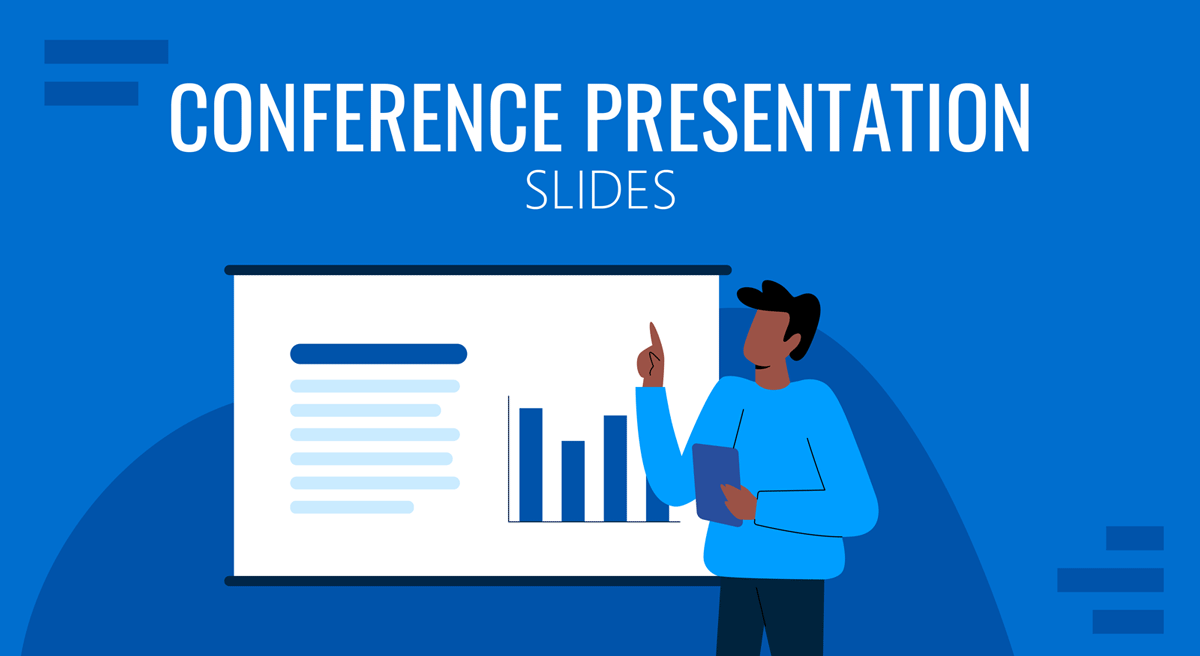
In our experience, a common error when preparing a conference presentation is using designs that heavily rely on bullet points and massive chunks of text. A potential reason behind this slide design mistake is aiming to include as much information as possible in just one slide. In the end, slides become a sort of teleprompter for the speaker, and the audience recalls boredom instead of an informative experience.
As part of our mission to help presenters deliver their message effectively, we have summarized what makes a good conference presentation slide, as well as tips on how to design a successful conference slide.
Table of Contents
What is a conference presentation
Common mistakes presenters make when creating conference presentation slides, how can a well-crafted conference presentation help your professional life, how to start a conference presentation, how to end a conference presentation, tailoring your message to different audiences, visualizing data effectively, engaging with your audience, designing for impact, mastering slide transitions and animation, handling time constraints, incorporating multimedia elements, post-presentation engagement, crisis management during presentations, sustainability and green presentations, measuring presentation success, 13 tips to create stellar conference presentations, final thoughts.
The Britannica Dictionary defines conferences as
A formal meeting in which many people gather in order to talk about ideas or problems related to a particular topic (such as medicine or business), usually for several days.
We can then define conference presentations as the combination of a speaker, a slide deck , and the required hardware to introduce an idea or topic in a conference setting. Some characteristics differentiate conference presentations from other formats.
Time-restricted
Conference presentations are bounded by a 15-30 minute time limit, which the event’s moderators establish. These restrictions are applied to allow a crowded agenda to be met on time, and it is common to count with over 10 speakers on the same day.
To that time limit, we have to add the time required for switching between speakers, which implies loading a new slide deck to the streaming platform, microphone testing, lighting effects, etc. Say it is around 10-15 minutes extra, so depending on the number of speakers per day during the event, the time available to deliver a presentation, plus the questions & answers time.
Delivery format
Conferences can be delivered in live event format or via webinars. Since this article is mainly intended to live event conferences, we will only mention that the requirements for webinars are as follows:
- Voice-over or, best, speaker layover the presentation slides so the speaker interacts with the audience.
- Quality graphics.
- Not abusing the amount of information to introduce per slide.
On the other hand, live event conferences will differ depending on the category under which they fall. Academic conferences have a structure in which there’s a previous poster session; then speakers start delivering their talks, then after 4-5 speakers, we have a coffee break. Those pauses help the AV crew to check the equipment, and they also become an opportunity for researchers to expand their network contacts.
Business conferences are usually more dynamic. Some presenters opt not to use slide decks, giving a powerful speech instead, as they feel much more comfortable that way. Other speakers at business conferences adopt videos to summarize their ideas and then proceed to speak.
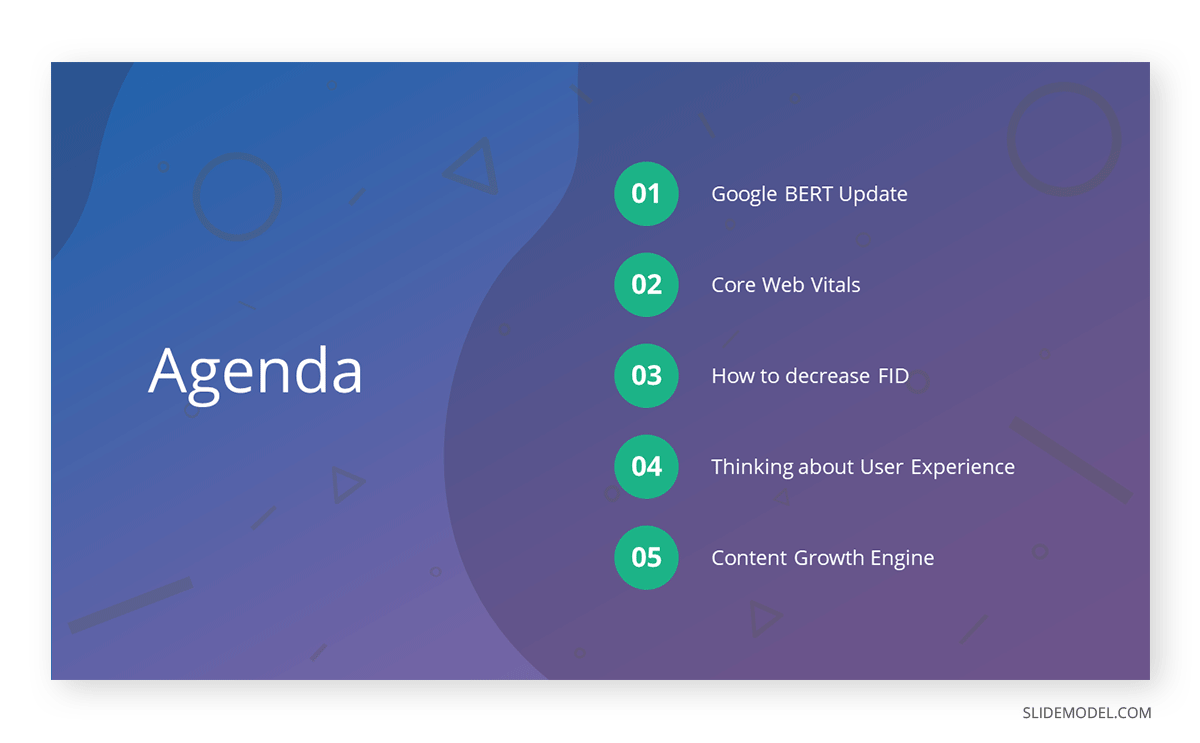
Overall, the format guidelines are sent to speakers before the event. Adapt your presentation style to meet the requirements of moderators so you can maximize the effect of your message.
The audience
Unlike other presentation settings, conferences gather a knowledgeable audience on the discussed topics. It is imperative to consider this, as tone, delivery format, information to include, and more depend on this sole factor. Moreover, the audience will participate in your presentation at the last minute, as it is a common practice to hold a Q&A session.
Mistake #1 – Massive chunks of text
Do you intend your audience to read your slides instead of being seduced by your presentation? Presenters often add large amounts of text to each slide since they need help deciding which data to exclude. Another excuse for this practice is so the audience remembers the content exposed.
Research indicates images are much better retained than words, a phenomenon known as the Picture Superiority Effect ; therefore, opt to avoid this tendency and work into creating compelling graphics.
Mistake #2 – Not creating contrast between data and graphics
Have you tried to read a slide from 4 rows behind the presenter and not get a single number? This can happen if the presenter is not careful to work with the appropriate contrast between the color of the typeface and the background. Particularly if serif fonts are used.
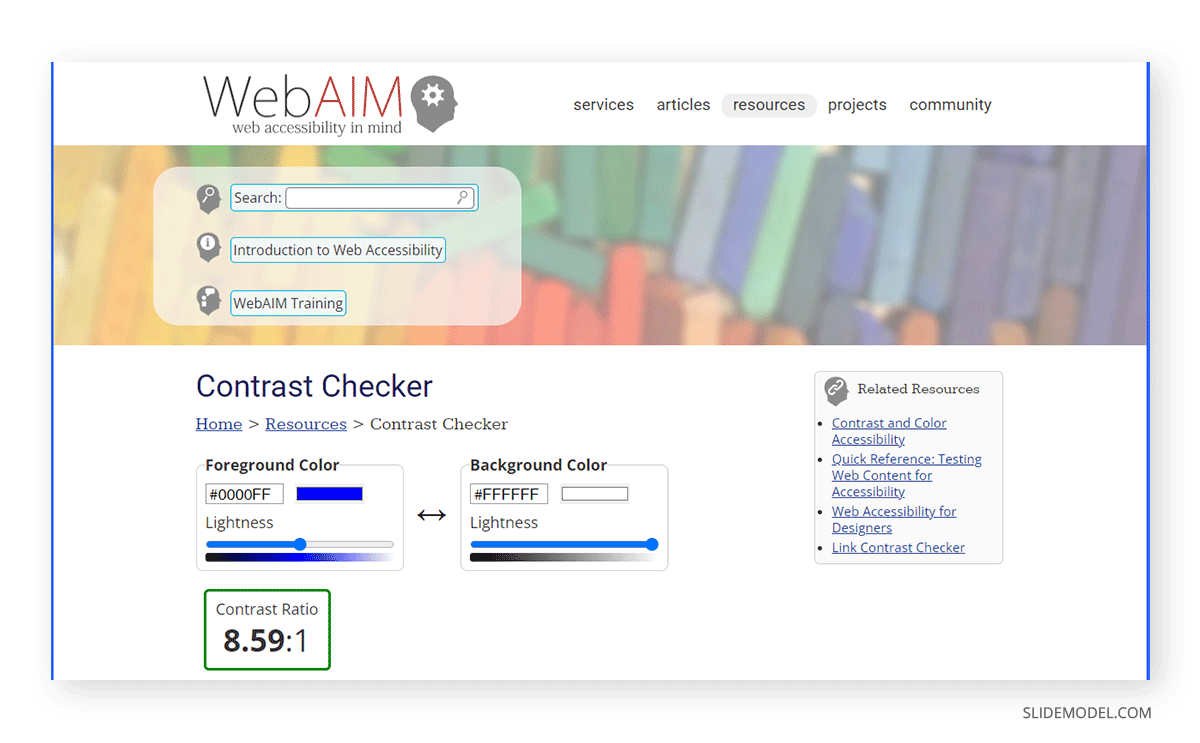
Use online tools such as WebAIM’s Contrast Checker to make your slides legible for your audience. Creating an overlay with a white or black transparent tint can also help when you place text above images.
Mistake #3 – Not rehearsing the presentation
This is a sin in conference presentations, as when you don’t practice the content you intend to deliver, you don’t have a measure of how much time it is actually going to take.
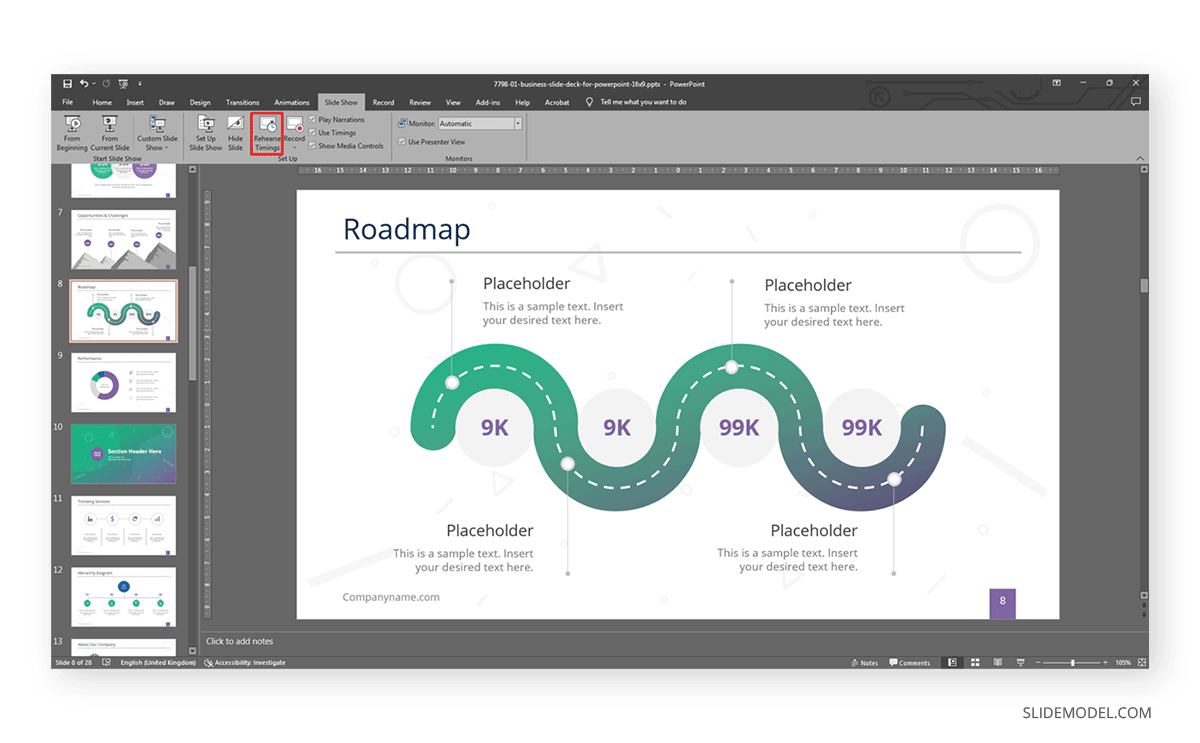
PowerPoint’s rehearse timing feature can help a great deal, as you can record yourself practising the presentation and observe areas for improvement. Remember, conference presentations are time-limited , don’t disrespect fellow speakers by overlapping their scheduled slot or, worse, have moderators trim your presentation after several warnings.
Mistake #4 – Lacking hierarchy for the presented content
Looking at a slide and not knowing where the main point is discouraging for the audience, especially if you introduce several pieces of content under the same slide. Instead, opt to create a hierarchy that comprehends both text and images. It helps to arrange the content according to your narrative, and we’ll see more on this later on.
Consider your conference presentation as your introduction card in the professional world. Maybe you have a broad network of colleagues, but be certain there are plenty of people out there that have yet to learn about who you are and the work you produce.
Conferences help businesspeople and academics alike to introduce the results of months of research on a specific topic in front of a knowledgeable audience. It is different from a product launch as you don’t need to present a “completed product” but rather your views or advances, in other words, your contribution with valuable insights to the field.
Putting dedication into your conference presentation, from the slide deck design to presentation skills , is definitely worth the effort. The audience can get valuable references from the quality of work you are able to produce, often leading to potential partnerships. In business conferences, securing an investor deal can happen after a powerful presentation that drives the audience to perceive your work as the very best thing that’s about to be launched. It is all about how your body language reflects your intent, how well-explained the concepts are, and the emotional impact you can drive from it.
There are multiple ways on how to start a presentation for a conference, but overall, we can recap a good approach as follows.
Present a fact
Nothing grabs the interest of an audience quicker than introducing an interesting fact during the first 30 seconds of your presentation. The said fact has to be pivotal to the content your conference presentation will discuss later on, but as an ice-breaker, it is a strategy worth applying from time to time.
Ask a question
The main point when starting a conference presentation is to make an impact on the audience. We cannot think of a better way to engage with the audience than to ask them a question relevant to your work or research. It grabs the viewer’s interest for the potential feedback you shall give to those answers received.
Use powerful graphics
The value of visual presentations cannot be neglected in conferences. Sometimes an image makes a bigger impact than a lengthy speech, hence why you should consider starting your conference presentation with a photo or visual element that speaks for itself.
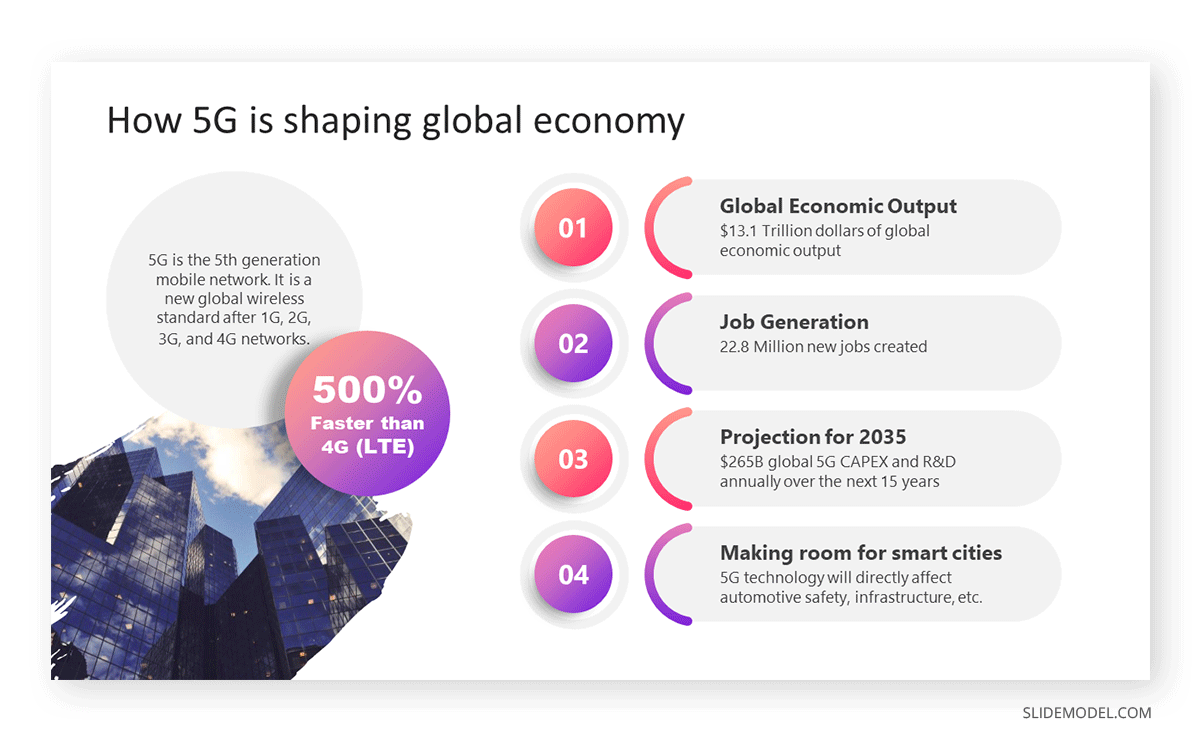
For more tips and insights on how to start a presentation , we invite you to check this article.
Just as important as starting the presentation, the closure you give to your conference presentation matters a lot. This is the opportunity in which you can add your personal experience on the topic and reflect upon it with the audience or smoothly transition between the presentation and your Q&A session.
Below are some quick tips on how to end a presentation for a conference event.
End the presentation with a quote
Give your audience something to ruminate about with the help of a quote tailored to the topic you were discussing. There are plenty of resources for finding suitable quotes, and a great method for this is to design your penultimate slide with an image or black background plus a quote. Follow this with a final “thank you” slide.
Consider a video
If we say a video whose length is shorter than 1 minute, this is a fantastic resource to summarize the intent of your conference presentation.
If you get the two-minute warning and you feel far off from finishing your presentation, first, don’t fret. Try to give a good closure when presenting in a conference without rushing information, as the audience wouldn’t get any concept clear that way. Mention that the information you presented will be available for further reading at the event’s platform site or your company’s digital business card , and proceed to your closure phase for the presentation.
It is better to miss some of the components of the conference than to get kicked out after several warnings for exceeding the allotted time.
Tailoring your conference presentation to suit your audience is crucial to delivering an impactful talk. Different audiences have varying levels of expertise, interests, and expectations. By customizing your content, tone, and examples, you can enhance the relevance and engagement of your presentation.
Understanding Audience Backgrounds and Expectations
Before crafting your presentation, research your audience’s backgrounds and interests. Are they professionals in your field, students, or a mix of both? Are they familiar with the topic, or must you provide more context? Understanding these factors will help you pitch your content correctly and avoid overwhelming or boring your audience.
Adapting Language and Tone for Relevance
Use language that resonates with your audience. Avoid jargon or technical terms that might confuse those unfamiliar with your field. Conversely, don’t oversimplify if your audience consists of experts. Adjust your tone to match the event’s formality and your listeners’ preferences.
Customizing Examples and Case Studies
Incorporate case studies, examples, and anecdotes that your audience can relate to. If you’re speaking to professionals, use real-world scenarios from their industry. For a more general audience, choose examples that are universally relatable. This personal touch makes your content relatable and memorable.
Effectively presenting data is essential for conveying complex information to your audience. Visualizations can help simplify intricate concepts and make your points more digestible.
Choosing the Right Data Representation
Select the appropriate type of graph or chart to illustrate your data. Bar graphs, pie charts, line charts, and scatter plots each serve specific purposes. Choose the one that best supports your message and ensures clarity.
Designing Graphs and Charts for Clarity
Ensure your graphs and charts are easily read. Use clear labels, appropriate color contrasts, and consistent scales. Avoid clutter and simplify the design to highlight the most important data points.
Incorporating Annotations and Explanations
Add annotations or callouts to your graphs to emphasize key findings. Explain the significance of each data point to guide your audience’s understanding. Utilize visual cues, such as arrows and labels, to direct attention.
Engaging your audience is a fundamental skill for a successful presentation for conference. Captivate their attention, encourage participation, and foster a positive connection.
Establishing Eye Contact and Body Language
Maintain eye contact with different audience parts to create a sense of connection. Effective body language, such as confident posture and expressive gestures, enhances your presence on stage.
Encouraging Participation and Interaction
Involve your audience through questions, polls, or interactive activities. Encourage them to share their thoughts or experiences related to your topic. This engagement fosters a more dynamic and memorable presentation.
Using Humor and Engaging Stories
Incorporate humor and relatable anecdotes to make your presentation more enjoyable. Well-timed jokes or personal stories can create a rapport with your audience and make your content more memorable.
The design of your conference presentation slides plays a crucial role in capturing and retaining your audience’s attention. Thoughtful design can amplify your message and reinforce key points. Take a look at these suggestions to boost the performance of your conference presentation slides, or create an entire slide deck in minutes by using SlideModel’s AI Presentation Maker from text .
Creating Memorable Opening Slides
Craft an opening slide that piques the audience’s curiosity and sets the tone for your presentation. Use an engaging visual, thought-provoking quote, or intriguing question to grab their attention from the start.
Using Visual Hierarchy for Emphasis
Employ visual hierarchy to guide your audience’s focus. Highlight key points with larger fonts, bold colors, or strategic placement. Organize information logically to enhance comprehension.
Designing a Powerful Closing Slide
End your presentation with a compelling closing slide that reinforces your main message. Summarize your key points, offer a memorable takeaway, or invite the audience to take action. Use visuals that resonate and leave a lasting impression.
Slide transitions and animations can enhance the flow of your presentation and emphasize important content. However, their use requires careful consideration to avoid distractions or confusion.
Enhancing Flow with Transitions
Select slide transitions that smoothly guide the audience from one point to the next. Avoid overly flashy transitions that detract from your content. Choose options that enhance, rather than disrupt, the presentation’s rhythm.
Using Animation to Highlight Points
Animate elements on your slides to draw attention to specific information. Animate text, images, or graphs to appear as you discuss them, helping the audience follow your narrative more effectively.
Avoiding Overuse of Effects
While animation can be engaging, avoid excessive use that might overwhelm or distract the audience. Maintain a balance between animated elements and static content for a polished presentation.
Effective time management is crucial for delivering a concise and impactful conference presentation within the allocated time frame.
Structuring for Short vs. Long Presentations
Adapt your content and pacing based on the duration of your presentation. Clearly outline the main points for shorter talks, and delve into more depth for longer sessions. Ensure your message aligns with the time available.
Prioritizing Key Information
Identify the core information you want your audience to take away. Focus on conveying these essential points, and be prepared to trim or elaborate on supporting details based on the available time.
Practicing Time Management
Rehearse your presentation while timing yourself to ensure you stay within the allocated time. Adjust your delivery speed to match your time limit, allowing for smooth transitions and adequate Q&A time.
Multimedia elements, such as videos, audio clips, and live demonstrations, can enrich your presentation and provide a dynamic experience for your audience.
Integrating Videos and Audio Clips
Use videos and audio clips strategically to reinforce your points or provide real-world examples. Ensure that the multimedia content is of high quality and directly supports your narrative.
Showcasing Live Demonstrations
Live demonstrations can engage the audience by showcasing practical applications of your topic. Practice the demonstration beforehand to ensure it runs smoothly and aligns with your message.
Using Hyperlinks for Additional Resources
Incorporate hyperlinks into your presentation to direct the audience to additional resources, references, or related content. This allows interested attendees to explore the topic further after the presentation.
Engaging with your audience after your presentation can extend the impact of your talk and foster valuable connections.
Leveraging Post-Presentation Materials
Make your presentation slides and related materials available to attendees after the event. Share them through email, a website, or a conference platform, allowing interested individuals to review the content.
Sharing Slides and Handouts
Provide downloadable versions of your slides and any handouts you used during the presentation. This helps attendees revisit key points and share the information with colleagues.
Networking and Following Up
Utilize networking opportunities during and after the conference to connect with attendees who are interested in your topic. Exchange contact information and follow up with personalized messages to continue the conversation.
Preparing for unexpected challenges during your presenting at a conference can help you maintain professionalism and composure, ensuring a seamless delivery.
Dealing with Technical Glitches
Technical issues can occur, from projector malfunctions to software crashes. Stay calm and have a backup plan, such as having your slides available on multiple devices or using printed handouts.
Handling Unexpected Interruptions
Interruptions, such as questions from the audience or unforeseen disruptions, are a normal part of live presentations. Address them politely, stay adaptable, and seamlessly return to your prepared content.
Staying Calm and Professional
Maintain a composed demeanor regardless of unexpected situations. Your ability to handle challenges gracefully reflects your professionalism and dedication to delivering a successful presentation.
Creating environmentally friendly presentations demonstrates your commitment to sustainability and responsible practices.
Designing Eco-Friendly Slides
Minimize the use of resources by designing slides with efficient layouts, avoiding unnecessary graphics or animations, and using eco-friendly color schemes.
Reducing Paper and Material Waste
Promote a paperless approach by encouraging attendees to access digital materials rather than printing handouts. If print materials are necessary, consider using recycled paper.
Promoting Sustainable Practices
Advocate for sustainability during your presentation by discussing relevant initiatives, practices, or innovations that align with environmentally conscious values.
Measuring the success of your conference presentation goes beyond the applause and immediate feedback. It involves assessing the impact of your presentation on your audience, goals, and growth as a presenter.
Collecting Audience Feedback
After presenting at a conference, gather feedback from attendees. Provide feedback forms or online surveys to capture their thoughts on the content, delivery, and visuals. Analyzing their feedback can reveal areas for improvement and give insights into audience preferences.
Evaluating Key Performance Metrics
Consider objective metrics such as audience engagement, participation, and post-presentation interactions. Did attendees ask questions? Did your content spark discussions? Tracking these metrics can help you gauge the effectiveness of your presentation in conveying your message.
Continuous Improvement Strategies
Use the feedback and insights gathered to enhance your future presentations. Identify strengths to build upon and weaknesses to address. Continuously refine your presentation skills , design choices, and content to create even more impactful presentations in the future.
Tip #1 – Exhibit a single idea per slide
Just one slide per concept, avoiding large text blocks. If you can compile the idea with an image, it’s better that way.
Research shows that people’s attention span is limited ; therefore, redirect your efforts in what concerns presentation slides so your ideas become crystal clear for the spectators.
Tip #2 – Avoid jargon whenever possible
Using complex terms does not directly imply you fully understand the concept you are about to discuss. In spite of your work being presented to a knowledgeable audience, avoid jargon as much as possible because you run the risk of people not understanding what you are saying.
Instead, opt to rehearse your presentation in front of a not-knowledgeable audience to measure the jargon volume you are adding to it. Technical terms are obviously expected in a conference situation, but archaic terms or purely jargon can be easily trimmed this way.
Tip #3 – Replace bulleted listings with structured layouts or diagrams
Bullet points are attention grabbers for the audience. People tend to instantly check what’s written in them, in contrast to waiting for you to introduce the point itself.
Using bullet points as a way to expose elements of your presentation should be restricted. Opt for limiting the bullet points to non-avoidable facts to list or crucial information.
Tip #4 – Customize presentation templates
Using presentation templates is a great idea to save time in design decisions. These pre-made slide decks are entirely customizable; however, many users fall into using them as they come, exposing themselves to design inconsistencies (especially with images) or that another presenter had the same idea (it is extremely rare, but it can happen).
Learning how to properly change color themes in PowerPoint is an advantageous asset. We also recommend you use your own images or royalty-free images selected by you rather than sticking to the ones included in a template.
Tip #5 – Displaying charts
Graphs and charts comprise around 80% of the information in most business and academic conferences. Since data visualization is important, avoid common pitfalls such as using 3D effects in bar charts. Depending on the audience’s point of view, those 3D effects can make the data hard to read or get an accurate interpretation of what it represents.
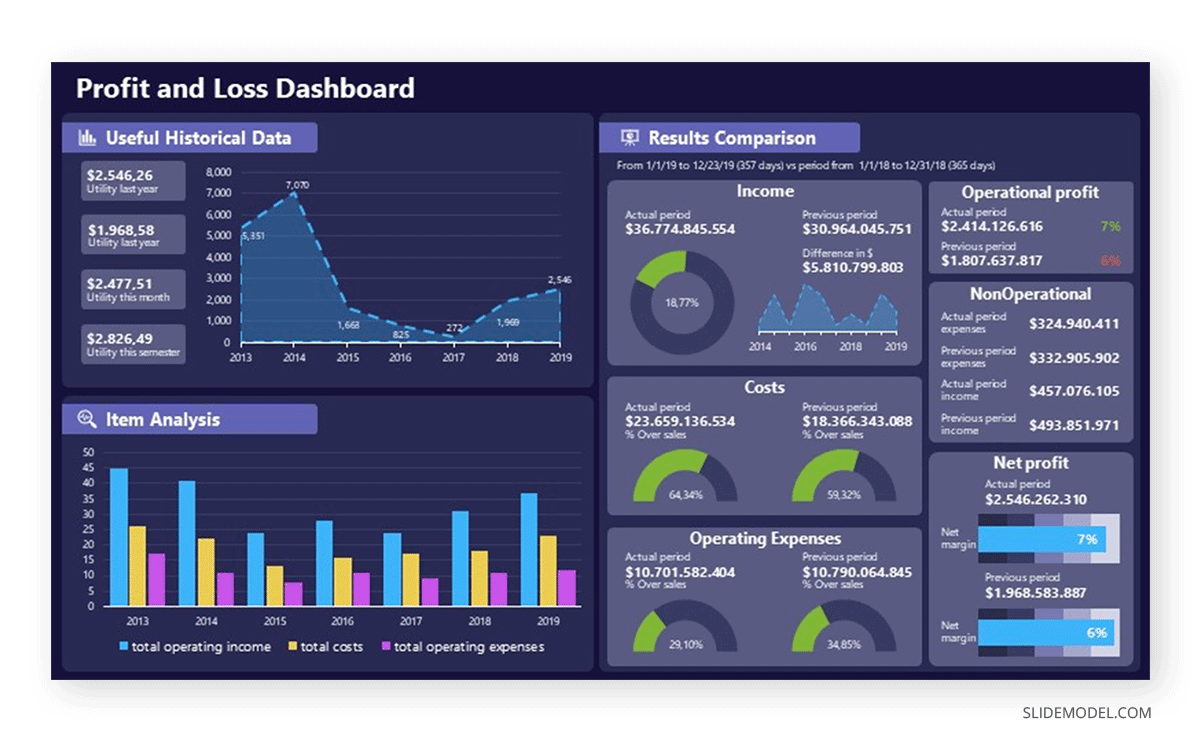
Tip #6 – Using images in the background
Use some of the images you were planning to expose as background for the slides – again, not all of them but relevant slides.
Be careful when placing text above the slides if they have a background image, as accessibility problems may arise due to contrast. Instead, apply an extra color layer above the image with reduced opacity – black or white, depending on the image and text requirements. This makes the text more legible for the audience, and you can use your images without any inconvenience.
Tip #7 – Embrace negative space
Negative space is a concept seen in design situations. If we consider positive space as the designed area, meaning the objects, shapes, etc., that are “your design,” negative space can be defined as the surrounding area. If we work on a white canvas, negative space is the remaining white area surrounding your design.
The main advantage of using negative space appropriately is to let your designs breathe. Stuffing charts, images and text makes it hard to get a proper understanding of what’s going on in the slide. Apply the “less is more” motto to your conference presentation slides, and embrace negative space as your new design asset.
Tip #8 – Use correct grammar, spelling, and punctuation
You would be surprised to see how many typos can be seen in slides at professional gatherings. Whereas typos can often pass by as a humor-relief moment, grammatical or awful spelling mistakes make you look unprofessional.
Take 5 extra minutes before submitting your slide deck to proofread the grammar, spelling, and punctuation. If in doubt, browse dictionaries for complex technical words.
Tip #10 – Use an appropriate presentation style
The format of the conference will undoubtedly require its own presentation style. By this we mean that it is different from delivering a conference presentation in front of a live audience as a webinar conference. The interaction with the audience is different, the demands for the Q&A session will be different, and also during webinars the audience is closely looking at your slides.
Tip #11 – Control your speaking tone
Another huge mistake when delivering a conference presentation is to speak with a monotonous tone. The message you transmit to your attendees is that you simply do not care about your work. If you believe you fall into this category, get feedback from others: try pitching to them, and afterward, consider how you talk.
Practicing breathing exercises can help to articulate your speech skills, especially if anxiety hinders your presentation performance.
Tip #12 – On eye contact and note reading
In order to connect with your audience, it is imperative to make eye contact. Not stare, but look at your spectators from time to time as the talk is directed at them.
If you struggle on this point, a good tip we can provide is to act like you’re looking at your viewers. Pick a good point a few centimeters above your viewer and direct your speech there. They will believe you are communicating directly with them. Shift your head slightly on the upcoming slide or bullet and choose a new location.
Regarding note reading, while it is an acceptable practice to check your notes, do not make the entire talk a lecture in which you simply read your notes to the audience. This goes hand-by-hand with the speaking tone in terms of demonstrating interest in the work you do. Practice as often as you need before the event to avoid constantly reading your notes. Reading a paragraph or two is okay, but not the entire presentation.
Tip #13 – Be ready for the Q&A session
Despite it being a requirement in most conference events, not all presenters get ready for the Q&A session. It is a part of the conference presentation itself, so you should pace your speech to give enough time for the audience to ask 1-3 questions and get a proper answer.
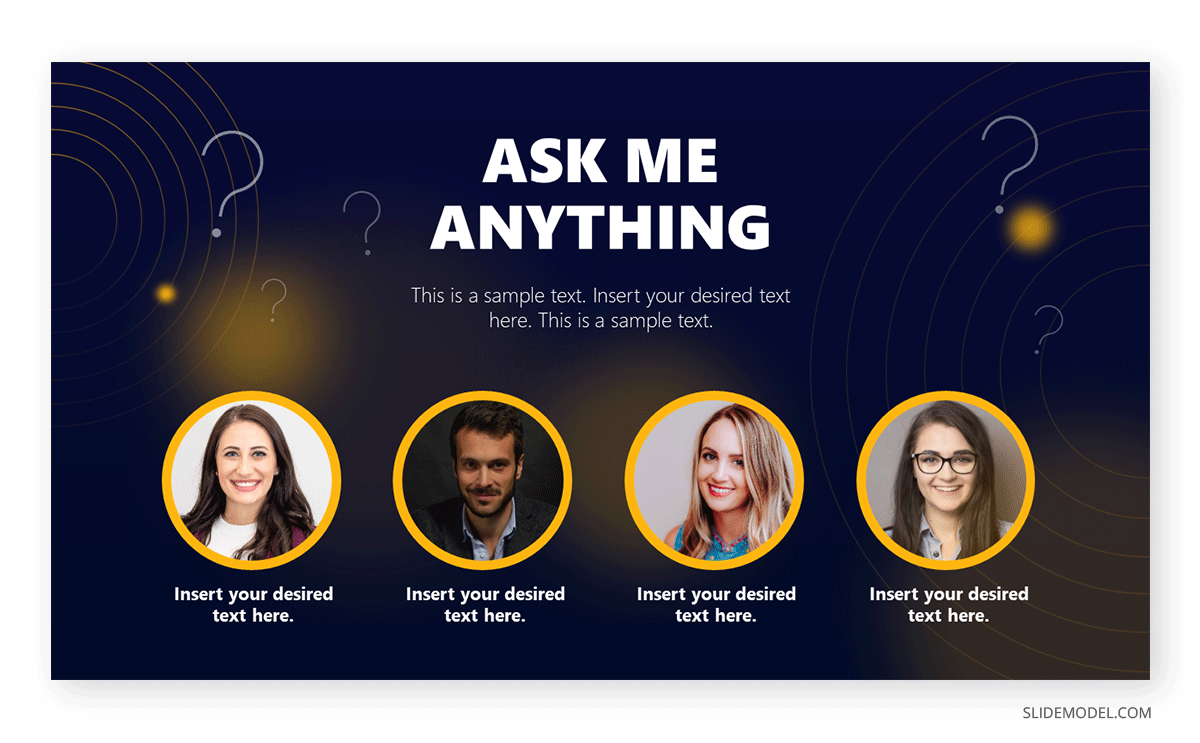
Don’t be lengthy or overbearing in replying to each question, as you may run out of time. It is preferable to give a general opinion and then reach the interested person with your contact information to discuss the topic in detail.
Observing what others do at conference events is good practice for learning a tip or two for improving your own work. As we have seen throughout this article, conference presentation slides have specific requirements to become a tool in your presentation rather than a mixture of information without order.
Employ these tips and suggestions to craft your upcoming conference presentation without any hurdles. Best of luck!
1. Conference PowerPoint Template
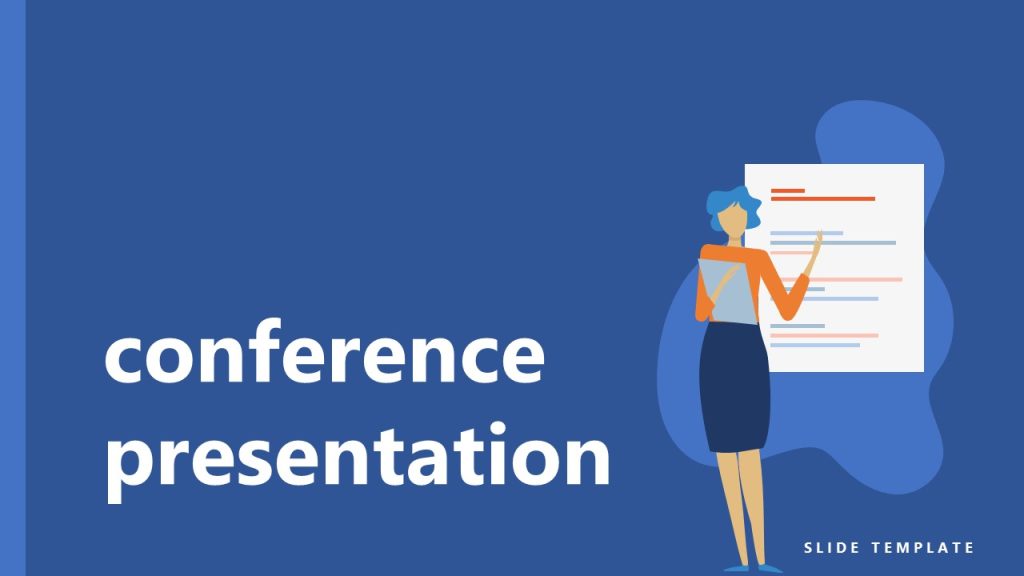
Use This Template
2. Free Conference Presentation Template
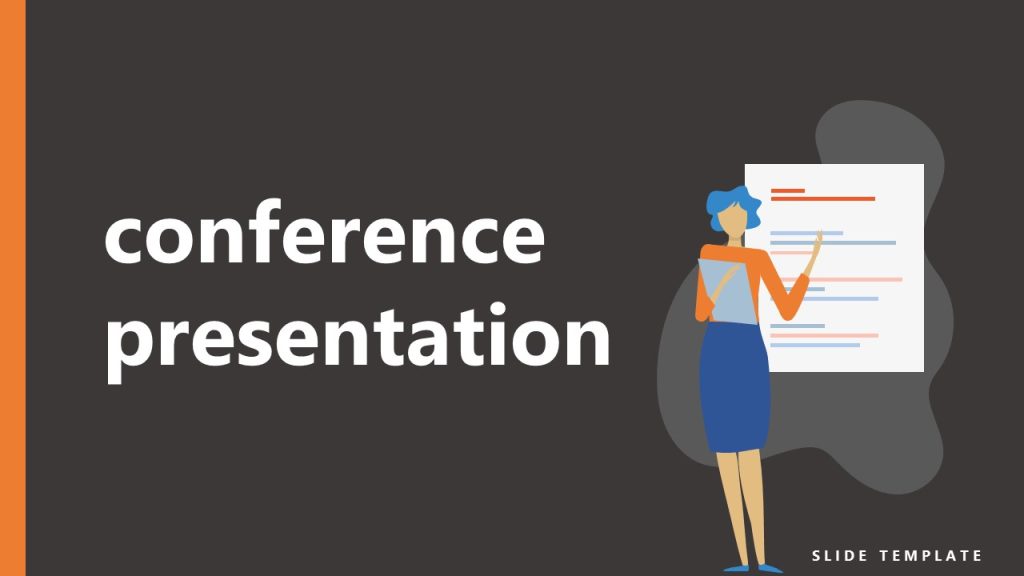
Like this article? Please share
Presentation Approaches, Presentation Skills, Presentation Tips Filed under Business
Related Articles

Filed under Google Slides Tutorials • May 3rd, 2024
How to Work with Google Slides Version History
Go back to previous changes or check who edited your presentation. Learn how to work with Google Slides Version History here.

Filed under Google Slides Tutorials • April 29th, 2024
Best Google Slides Add-Ons
Optimize your Google Slides experience by installing the best Google Slides add-ons available in the market. Full list with photos.

Filed under Design • April 23rd, 2024
How to Create the Perfect Handouts for a Presentation
Learn how to create effective handouts for presentations and the recommended structure for handouts with this guide.
Leave a Reply

- Publication Recognition
How to Make a PowerPoint Presentation of Your Research Paper
- 4 minute read
- 125.2K views
Table of Contents
A research paper presentation is often used at conferences and in other settings where you have an opportunity to share your research, and get feedback from your colleagues. Although it may seem as simple as summarizing your research and sharing your knowledge, successful research paper PowerPoint presentation examples show us that there’s a little bit more than that involved.
In this article, we’ll highlight how to make a PowerPoint presentation from a research paper, and what to include (as well as what NOT to include). We’ll also touch on how to present a research paper at a conference.
Purpose of a Research Paper Presentation
The purpose of presenting your paper at a conference or forum is different from the purpose of conducting your research and writing up your paper. In this setting, you want to highlight your work instead of including every detail of your research. Likewise, a presentation is an excellent opportunity to get direct feedback from your colleagues in the field. But, perhaps the main reason for presenting your research is to spark interest in your work, and entice the audience to read your research paper.
So, yes, your presentation should summarize your work, but it needs to do so in a way that encourages your audience to seek out your work, and share their interest in your work with others. It’s not enough just to present your research dryly, to get information out there. More important is to encourage engagement with you, your research, and your work.
Tips for Creating Your Research Paper Presentation
In addition to basic PowerPoint presentation recommendations, which we’ll cover later in this article, think about the following when you’re putting together your research paper presentation:
- Know your audience : First and foremost, who are you presenting to? Students? Experts in your field? Potential funders? Non-experts? The truth is that your audience will probably have a bit of a mix of all of the above. So, make sure you keep that in mind as you prepare your presentation.
Know more about: Discover the Target Audience .
- Your audience is human : In other words, they may be tired, they might be wondering why they’re there, and they will, at some point, be tuning out. So, take steps to help them stay interested in your presentation. You can do that by utilizing effective visuals, summarize your conclusions early, and keep your research easy to understand.
- Running outline : It’s not IF your audience will drift off, or get lost…it’s WHEN. Keep a running outline, either within the presentation or via a handout. Use visual and verbal clues to highlight where you are in the presentation.
- Where does your research fit in? You should know of work related to your research, but you don’t have to cite every example. In addition, keep references in your presentation to the end, or in the handout. Your audience is there to hear about your work.
- Plan B : Anticipate possible questions for your presentation, and prepare slides that answer those specific questions in more detail, but have them at the END of your presentation. You can then jump to them, IF needed.
What Makes a PowerPoint Presentation Effective?
You’ve probably attended a presentation where the presenter reads off of their PowerPoint outline, word for word. Or where the presentation is busy, disorganized, or includes too much information. Here are some simple tips for creating an effective PowerPoint Presentation.
- Less is more: You want to give enough information to make your audience want to read your paper. So include details, but not too many, and avoid too many formulas and technical jargon.
- Clean and professional : Avoid excessive colors, distracting backgrounds, font changes, animations, and too many words. Instead of whole paragraphs, bullet points with just a few words to summarize and highlight are best.
- Know your real-estate : Each slide has a limited amount of space. Use it wisely. Typically one, no more than two points per slide. Balance each slide visually. Utilize illustrations when needed; not extraneously.
- Keep things visual : Remember, a PowerPoint presentation is a powerful tool to present things visually. Use visual graphs over tables and scientific illustrations over long text. Keep your visuals clean and professional, just like any text you include in your presentation.
Know more about our Scientific Illustrations Services .
Another key to an effective presentation is to practice, practice, and then practice some more. When you’re done with your PowerPoint, go through it with friends and colleagues to see if you need to add (or delete excessive) information. Double and triple check for typos and errors. Know the presentation inside and out, so when you’re in front of your audience, you’ll feel confident and comfortable.
How to Present a Research Paper
If your PowerPoint presentation is solid, and you’ve practiced your presentation, that’s half the battle. Follow the basic advice to keep your audience engaged and interested by making eye contact, encouraging questions, and presenting your information with enthusiasm.
We encourage you to read our articles on how to present a scientific journal article and tips on giving good scientific presentations .
Language Editing Plus
Improve the flow and writing of your research paper with Language Editing Plus. This service includes unlimited editing, manuscript formatting for the journal of your choice, reference check and even a customized cover letter. Learn more here , and get started today!

- Manuscript Preparation
Know How to Structure Your PhD Thesis

- Research Process
Systematic Literature Review or Literature Review?
You may also like.

What is a Good H-index?

What is a Corresponding Author?

How to Submit a Paper for Publication in a Journal
Input your search keywords and press Enter.
Research Conference Presentations: Some Tips and Examples
Useful Tips
Research talk 101 (by Lucia Dettori)
How not to give a presentation (from ScienceRoll)
Examples of Short Talks (PowerPoint files):
Mark's example of a bad research presentation
Mark's example of a somewhat better research presentation
Examples of Posters (PowerPoint files):
Poster example 1
Poster example 2
Poster example 3
Reference management. Clean and simple.
How to make a scientific presentation

Scientific presentation outlines
Questions to ask yourself before you write your talk, 1. how much time do you have, 2. who will you speak to, 3. what do you want the audience to learn from your talk, step 1: outline your presentation, step 2: plan your presentation slides, step 3: make the presentation slides, slide design, text elements, animations and transitions, step 4: practice your presentation, final thoughts, frequently asked questions about preparing scientific presentations, related articles.
A good scientific presentation achieves three things: you communicate the science clearly, your research leaves a lasting impression on your audience, and you enhance your reputation as a scientist.
But, what is the best way to prepare for a scientific presentation? How do you start writing a talk? What details do you include, and what do you leave out?
It’s tempting to launch into making lots of slides. But, starting with the slides can mean you neglect the narrative of your presentation, resulting in an overly detailed, boring talk.
The key to making an engaging scientific presentation is to prepare the narrative of your talk before beginning to construct your presentation slides. Planning your talk will ensure that you tell a clear, compelling scientific story that will engage the audience.
In this guide, you’ll find everything you need to know to make a good oral scientific presentation, including:
- The different types of oral scientific presentations and how they are delivered;
- How to outline a scientific presentation;
- How to make slides for a scientific presentation.
Our advice results from delving into the literature on writing scientific talks and from our own experiences as scientists in giving and listening to presentations. We provide tips and best practices for giving scientific talks in a separate post.
There are two main types of scientific talks:
- Your talk focuses on a single study . Typically, you tell the story of a single scientific paper. This format is common for short talks at contributed sessions in conferences.
- Your talk describes multiple studies. You tell the story of multiple scientific papers. It is crucial to have a theme that unites the studies, for example, an overarching question or problem statement, with each study representing specific but different variations of the same theme. Typically, PhD defenses, invited seminars, lectures, or talks for a prospective employer (i.e., “job talks”) fall into this category.
➡️ Learn how to prepare an excellent thesis defense
The length of time you are allotted for your talk will determine whether you will discuss a single study or multiple studies, and which details to include in your story.
The background and interests of your audience will determine the narrative direction of your talk, and what devices you will use to get their attention. Will you be speaking to people specializing in your field, or will the audience also contain people from disciplines other than your own? To reach non-specialists, you will need to discuss the broader implications of your study outside your field.
The needs of the audience will also determine what technical details you will include, and the language you will use. For example, an undergraduate audience will have different needs than an audience of seasoned academics. Students will require a more comprehensive overview of background information and explanations of jargon but will need less technical methodological details.
Your goal is to speak to the majority. But, make your talk accessible to the least knowledgeable person in the room.
This is called the thesis statement, or simply the “take-home message”. Having listened to your talk, what message do you want the audience to take away from your presentation? Describe the main idea in one or two sentences. You want this theme to be present throughout your presentation. Again, the thesis statement will depend on the audience and the type of talk you are giving.
Your thesis statement will drive the narrative for your talk. By deciding the take-home message you want to convince the audience of as a result of listening to your talk, you decide how the story of your talk will flow and how you will navigate its twists and turns. The thesis statement tells you the results you need to show, which subsequently tells you the methods or studies you need to describe, which decides the angle you take in your introduction.
➡️ Learn how to write a thesis statement
The goal of your talk is that the audience leaves afterward with a clear understanding of the key take-away message of your research. To achieve that goal, you need to tell a coherent, logical story that conveys your thesis statement throughout the presentation. You can tell your story through careful preparation of your talk.
Preparation of a scientific presentation involves three separate stages: outlining the scientific narrative, preparing slides, and practicing your delivery. Making the slides of your talk without first planning what you are going to say is inefficient.
Here, we provide a 4 step guide to writing your scientific presentation:
- Outline your presentation
- Plan your presentation slides
- Make the presentation slides
- Practice your presentation

Writing an outline helps you consider the key pieces of your talk and how they fit together from the beginning, preventing you from forgetting any important details. It also means you avoid changing the order of your slides multiple times, saving you time.
Plan your talk as discrete sections. In the table below, we describe the sections for a single study talk vs. a talk discussing multiple studies:
The following tips apply when writing the outline of a single study talk. You can easily adapt this framework if you are writing a talk discussing multiple studies.
Introduction: Writing the introduction can be the hardest part of writing a talk. And when giving it, it’s the point where you might be at your most nervous. But preparing a good, concise introduction will settle your nerves.
The introduction tells the audience the story of why you studied your topic. A good introduction succinctly achieves four things, in the following order.
- It gives a broad perspective on the problem or topic for people in the audience who may be outside your discipline (i.e., it explains the big-picture problem motivating your study).
- It describes why you did the study, and why the audience should care.
- It gives a brief indication of how your study addressed the problem and provides the necessary background information that the audience needs to understand your work.
- It indicates what the audience will learn from the talk, and prepares them for what will come next.
A good introduction not only gives the big picture and motivations behind your study but also concisely sets the stage for what the audience will learn from the talk (e.g., the questions your work answers, and/or the hypotheses that your work tests). The end of the introduction will lead to a natural transition to the methods.
Give a broad perspective on the problem. The easiest way to start with the big picture is to think of a hook for the first slide of your presentation. A hook is an opening that gets the audience’s attention and gets them interested in your story. In science, this might take the form of a why, or a how question, or it could be a statement about a major problem or open question in your field. Other examples of hooks include quotes, short anecdotes, or interesting statistics.
Why should the audience care? Next, decide on the angle you are going to take on your hook that links to the thesis of your talk. In other words, you need to set the context, i.e., explain why the audience should care. For example, you may introduce an observation from nature, a pattern in experimental data, or a theory that you want to test. The audience must understand your motivations for the study.
Supplementary details. Once you have established the hook and angle, you need to include supplementary details to support them. For example, you might state your hypothesis. Then go into previous work and the current state of knowledge. Include citations of these studies. If you need to introduce some technical methodological details, theory, or jargon, do it here.
Conclude your introduction. The motivation for the work and background information should set the stage for the conclusion of the introduction, where you describe the goals of your study, and any hypotheses or predictions. Let the audience know what they are going to learn.
Methods: The audience will use your description of the methods to assess the approach you took in your study and to decide whether your findings are credible. Tell the story of your methods in chronological order. Use visuals to describe your methods as much as possible. If you have equations, make sure to take the time to explain them. Decide what methods to include and how you will show them. You need enough detail so that your audience will understand what you did and therefore can evaluate your approach, but avoid including superfluous details that do not support your main idea. You want to avoid the common mistake of including too much data, as the audience can read the paper(s) later.
Results: This is the evidence you present for your thesis. The audience will use the results to evaluate the support for your main idea. Choose the most important and interesting results—those that support your thesis. You don’t need to present all the results from your study (indeed, you most likely won’t have time to present them all). Break down complex results into digestible pieces, e.g., comparisons over multiple slides (more tips in the next section).
Summary: Summarize your main findings. Displaying your main findings through visuals can be effective. Emphasize the new contributions to scientific knowledge that your work makes.
Conclusion: Complete the circle by relating your conclusions to the big picture topic in your introduction—and your hook, if possible. It’s important to describe any alternative explanations for your findings. You might also speculate on future directions arising from your research. The slides that comprise your conclusion do not need to state “conclusion”. Rather, the concluding slide title should be a declarative sentence linking back to the big picture problem and your main idea.
It’s important to end well by planning a strong closure to your talk, after which you will thank the audience. Your closing statement should relate to your thesis, perhaps by stating it differently or memorably. Avoid ending awkwardly by memorizing your closing sentence.
By now, you have an outline of the story of your talk, which you can use to plan your slides. Your slides should complement and enhance what you will say. Use the following steps to prepare your slides.
- Write the slide titles to match your talk outline. These should be clear and informative declarative sentences that succinctly give the main idea of the slide (e.g., don’t use “Methods” as a slide title). Have one major idea per slide. In a YouTube talk on designing effective slides , researcher Michael Alley shows examples of instructive slide titles.
- Decide how you will convey the main idea of the slide (e.g., what figures, photographs, equations, statistics, references, or other elements you will need). The body of the slide should support the slide’s main idea.
- Under each slide title, outline what you want to say, in bullet points.
In sum, for each slide, prepare a title that summarizes its major idea, a list of visual elements, and a summary of the points you will make. Ensure each slide connects to your thesis. If it doesn’t, then you don’t need the slide.
Slides for scientific presentations have three major components: text (including labels and legends), graphics, and equations. Here, we give tips on how to present each of these components.
- Have an informative title slide. Include the names of all coauthors and their affiliations. Include an attractive image relating to your study.
- Make the foreground content of your slides “pop” by using an appropriate background. Slides that have white backgrounds with black text work well for small rooms, whereas slides with black backgrounds and white text are suitable for large rooms.
- The layout of your slides should be simple. Pay attention to how and where you lay the visual and text elements on each slide. It’s tempting to cram information, but you need lots of empty space. Retain space at the sides and bottom of your slides.
- Use sans serif fonts with a font size of at least 20 for text, and up to 40 for slide titles. Citations can be in 14 font and should be included at the bottom of the slide.
- Use bold or italics to emphasize words, not underlines or caps. Keep these effects to a minimum.
- Use concise text . You don’t need full sentences. Convey the essence of your message in as few words as possible. Write down what you’d like to say, and then shorten it for the slide. Remove unnecessary filler words.
- Text blocks should be limited to two lines. This will prevent you from crowding too much information on the slide.
- Include names of technical terms in your talk slides, especially if they are not familiar to everyone in the audience.
- Proofread your slides. Typos and grammatical errors are distracting for your audience.
- Include citations for the hypotheses or observations of other scientists.
- Good figures and graphics are essential to sustain audience interest. Use graphics and photographs to show the experiment or study system in action and to explain abstract concepts.
- Don’t use figures straight from your paper as they may be too detailed for your talk, and details like axes may be too small. Make new versions if necessary. Make them large enough to be visible from the back of the room.
- Use graphs to show your results, not tables. Tables are difficult for your audience to digest! If you must present a table, keep it simple.
- Label the axes of graphs and indicate the units. Label important components of graphics and photographs and include captions. Include sources for graphics that are not your own.
- Explain all the elements of a graph. This includes the axes, what the colors and markers mean, and patterns in the data.
- Use colors in figures and text in a meaningful, not random, way. For example, contrasting colors can be effective for pointing out comparisons and/or differences. Don’t use neon colors or pastels.
- Use thick lines in figures, and use color to create contrasts in the figures you present. Don’t use red/green or red/blue combinations, as color-blind audience members can’t distinguish between them.
- Arrows or circles can be effective for drawing attention to key details in graphs and equations. Add some text annotations along with them.
- Write your summary and conclusion slides using graphics, rather than showing a slide with a list of bullet points. Showing some of your results again can be helpful to remind the audience of your message.
- If your talk has equations, take time to explain them. Include text boxes to explain variables and mathematical terms, and put them under each term in the equation.
- Combine equations with a graphic that shows the scientific principle, or include a diagram of the mathematical model.
- Use animations judiciously. They are helpful to reveal complex ideas gradually, for example, if you need to make a comparison or contrast or to build a complicated argument or figure. For lists, reveal one bullet point at a time. New ideas appearing sequentially will help your audience follow your logic.
- Slide transitions should be simple. Silly ones distract from your message.
- Decide how you will make the transition as you move from one section of your talk to the next. For example, if you spend time talking through details, provide a summary afterward, especially in a long talk. Another common tactic is to have a “home slide” that you return to multiple times during the talk that reinforces your main idea or message. In her YouTube talk on designing effective scientific presentations , Stanford biologist Susan McConnell suggests using the approach of home slides to build a cohesive narrative.
To deliver a polished presentation, it is essential to practice it. Here are some tips.
- For your first run-through, practice alone. Pay attention to your narrative. Does your story flow naturally? Do you know how you will start and end? Are there any awkward transitions? Do animations help you tell your story? Do your slides help to convey what you are saying or are they missing components?
- Next, practice in front of your advisor, and/or your peers (e.g., your lab group). Ask someone to time your talk. Take note of their feedback and the questions that they ask you (you might be asked similar questions during your real talk).
- Edit your talk, taking into account the feedback you’ve received. Eliminate superfluous slides that don’t contribute to your takeaway message.
- Practice as many times as needed to memorize the order of your slides and the key transition points of your talk. However, don’t try to learn your talk word for word. Instead, memorize opening and closing statements, and sentences at key junctures in the presentation. Your presentation should resemble a serious but spontaneous conversation with the audience.
- Practicing multiple times also helps you hone the delivery of your talk. While rehearsing, pay attention to your vocal intonations and speed. Make sure to take pauses while you speak, and make eye contact with your imaginary audience.
- Make sure your talk finishes within the allotted time, and remember to leave time for questions. Conferences are particularly strict on run time.
- Anticipate questions and challenges from the audience, and clarify ambiguities within your slides and/or speech in response.
- If you anticipate that you could be asked questions about details but you don’t have time to include them, or they detract from the main message of your talk, you can prepare slides that address these questions and place them after the final slide of your talk.
➡️ More tips for giving scientific presentations
An organized presentation with a clear narrative will help you communicate your ideas effectively, which is essential for engaging your audience and conveying the importance of your work. Taking time to plan and outline your scientific presentation before writing the slides will help you manage your nerves and feel more confident during the presentation, which will improve your overall performance.
A good scientific presentation has an engaging scientific narrative with a memorable take-home message. It has clear, informative slides that enhance what the speaker says. You need to practice your talk many times to ensure you deliver a polished presentation.
First, consider who will attend your presentation, and what you want the audience to learn about your research. Tailor your content to their level of knowledge and interests. Second, create an outline for your presentation, including the key points you want to make and the evidence you will use to support those points. Finally, practice your presentation several times to ensure that it flows smoothly and that you are comfortable with the material.
Prepare an opening that immediately gets the audience’s attention. A common device is a why or a how question, or a statement of a major open problem in your field, but you could also start with a quote, interesting statistic, or case study from your field.
Scientific presentations typically either focus on a single study (e.g., a 15-minute conference presentation) or tell the story of multiple studies (e.g., a PhD defense or 50-minute conference keynote talk). For a single study talk, the structure follows the scientific paper format: Introduction, Methods, Results, Summary, and Conclusion, whereas the format of a talk discussing multiple studies is more complex, but a theme unifies the studies.
Ensure you have one major idea per slide, and convey that idea clearly (through images, equations, statistics, citations, video, etc.). The slide should include a title that summarizes the major point of the slide, should not contain too much text or too many graphics, and color should be used meaningfully.


Princeton Correspondents on Undergraduate Research
How to Make a Successful Research Presentation
Turning a research paper into a visual presentation is difficult; there are pitfalls, and navigating the path to a brief, informative presentation takes time and practice. As a TA for GEO/WRI 201: Methods in Data Analysis & Scientific Writing this past fall, I saw how this process works from an instructor’s standpoint. I’ve presented my own research before, but helping others present theirs taught me a bit more about the process. Here are some tips I learned that may help you with your next research presentation:
More is more
In general, your presentation will always benefit from more practice, more feedback, and more revision. By practicing in front of friends, you can get comfortable with presenting your work while receiving feedback. It is hard to know how to revise your presentation if you never practice. If you are presenting to a general audience, getting feedback from someone outside of your discipline is crucial. Terms and ideas that seem intuitive to you may be completely foreign to someone else, and your well-crafted presentation could fall flat.
Less is more
Limit the scope of your presentation, the number of slides, and the text on each slide. In my experience, text works well for organizing slides, orienting the audience to key terms, and annotating important figures–not for explaining complex ideas. Having fewer slides is usually better as well. In general, about one slide per minute of presentation is an appropriate budget. Too many slides is usually a sign that your topic is too broad.

Limit the scope of your presentation
Don’t present your paper. Presentations are usually around 10 min long. You will not have time to explain all of the research you did in a semester (or a year!) in such a short span of time. Instead, focus on the highlight(s). Identify a single compelling research question which your work addressed, and craft a succinct but complete narrative around it.
You will not have time to explain all of the research you did. Instead, focus on the highlights. Identify a single compelling research question which your work addressed, and craft a succinct but complete narrative around it.
Craft a compelling research narrative
After identifying the focused research question, walk your audience through your research as if it were a story. Presentations with strong narrative arcs are clear, captivating, and compelling.
- Introduction (exposition — rising action)
Orient the audience and draw them in by demonstrating the relevance and importance of your research story with strong global motive. Provide them with the necessary vocabulary and background knowledge to understand the plot of your story. Introduce the key studies (characters) relevant in your story and build tension and conflict with scholarly and data motive. By the end of your introduction, your audience should clearly understand your research question and be dying to know how you resolve the tension built through motive.

- Methods (rising action)
The methods section should transition smoothly and logically from the introduction. Beware of presenting your methods in a boring, arc-killing, ‘this is what I did.’ Focus on the details that set your story apart from the stories other people have already told. Keep the audience interested by clearly motivating your decisions based on your original research question or the tension built in your introduction.
- Results (climax)
Less is usually more here. Only present results which are clearly related to the focused research question you are presenting. Make sure you explain the results clearly so that your audience understands what your research found. This is the peak of tension in your narrative arc, so don’t undercut it by quickly clicking through to your discussion.
- Discussion (falling action)
By now your audience should be dying for a satisfying resolution. Here is where you contextualize your results and begin resolving the tension between past research. Be thorough. If you have too many conflicts left unresolved, or you don’t have enough time to present all of the resolutions, you probably need to further narrow the scope of your presentation.
- Conclusion (denouement)
Return back to your initial research question and motive, resolving any final conflicts and tying up loose ends. Leave the audience with a clear resolution of your focus research question, and use unresolved tension to set up potential sequels (i.e. further research).
Use your medium to enhance the narrative
Visual presentations should be dominated by clear, intentional graphics. Subtle animation in key moments (usually during the results or discussion) can add drama to the narrative arc and make conflict resolutions more satisfying. You are narrating a story written in images, videos, cartoons, and graphs. While your paper is mostly text, with graphics to highlight crucial points, your slides should be the opposite. Adapting to the new medium may require you to create or acquire far more graphics than you included in your paper, but it is necessary to create an engaging presentation.
The most important thing you can do for your presentation is to practice and revise. Bother your friends, your roommates, TAs–anybody who will sit down and listen to your work. Beyond that, think about presentations you have found compelling and try to incorporate some of those elements into your own. Remember you want your work to be comprehensible; you aren’t creating experts in 10 minutes. Above all, try to stay passionate about what you did and why. You put the time in, so show your audience that it’s worth it.
For more insight into research presentations, check out these past PCUR posts written by Emma and Ellie .
— Alec Getraer, Natural Sciences Correspondent
Share this:
- Share on Tumblr


Researched by Consultants from Top-Tier Management Companies

Powerpoint Templates
Icon Bundle
Kpi Dashboard
Professional
Business Plans
Swot Analysis
Gantt Chart
Business Proposal
Marketing Plan
Project Management
Business Case
Business Model
Cyber Security
Business PPT
Digital Marketing
Digital Transformation
Human Resources
Product Management
Artificial Intelligence
Company Profile
Acknowledgement PPT
PPT Presentation
Reports Brochures
One Page Pitch
Interview PPT
All Categories
Top 10 Research Presentation Templates with Examples and Samples

Simran Shekhawat
Research organizes all your thoughts, suggestions, findings and innovations in one area that postulates to determining the future applicability. A crucial part of strategic planning is research. It aids organizations in goal setting, decision-making, and resource allocation. Research allows us to uncover and discover many segments of society by establishing facts and generating data that effectively determine future outcomes and progress.
Here's an ultimate guide to conduct market research! Click to know more!
Research primarily comprises gathering and analysing information about consumer behaviour, industry dynamics, economic conditions, and other elements that affect how markets and businesses behave in the context of understanding market trends. Understanding market trends requires market research, which is likely to be successful. Research can reveal prospective market dangers and difficulties, enabling organizations to create backup plans and decide on market entry or expansion with more excellent knowledge. By understanding market trends, businesses can create marketing and advertising efforts that resonate with their target audience.
Learn about product market research templates. Click here .
Additionally, it aids in determining the best customer-reach methods. Businesses can better satisfy market demands by customizing their products or services by studying consumer behaviours, preferences, and feedback. Assessing Market Size and Potential research can shed light on a market's size, potential for expansion, and competitive environment. Businesses aiming to expand or enter new markets need to know this information.
SlideTeam introduces you with their newly launch research templates that has been extensively built to enhance the quality of company’s research and development area by forging to bring answers related to every ‘how’ and ‘why’. The sole purpose of these is to inform, gather information and contributes towards the development and knowledge about the field of study. These templates are professionally design to disseminate knowledge to provide better judgements.
Template 1: Clinical Research Trial PowerPoint Template

Use this premium PPT template to captivate your audience. Download this well-created template to raise your presenting threshold. Establish your milestones with workflows designed to ease the overburdening of tasks. State clear-cut objectives to specify your aim and deliver a timeline. Use these 58-page PowerPoint slides to launch your product success and deliver a presentation that awakes the audience with your research performance and goals.
Click here!
Template 2: Company Stock Analysis and Equity Research Report Slide

Uncover impacts about the stock markets and analyze company-related specific and general equity design using this ready-made template. Understanding the technicality of maintenance and presentation of stocks and equity research, we at SlideTeam have designed an equity research PowerPoint slide to ease your presentation load. This presentation aims to analyze the target company's financial performance, ratios, and financial model to welcome investment in the company. Provide an extensive company summary, income statement, balance sheet, vertical and horizontal analysis, organization shareholding structure, SWOT analysis, and share price performance throughout history through this template.
Download Now!
Template 3: IT Services Research and Development Template

Showcase the power of your company's services, expertise achievement and future goals using this PPT template. This PPT slide provides you with a summary, key statistics, targets, and overview of your IT service Company. Allow this template to lay out values mission, categorize solutions, and enlist a range of services provided along with expenditure incurred on Research development. The deck also includes a business model canvas that depicts the company's historical development, global reach, management team, organizational structure, employee breakdown, and ownership structure.
Template 4: Research Proposal Steps PowerPoint Template

If you are looking to learn how to draft a research proposal, this slide is the ultimate fit for a newbie to comprehend about - 'what', 'where', and 'how' of research. Download this slide to learn about the format and structure of the research proposal. Use this template to illustrate the goal of the research proposal. Furthermore, our PPT sample file aids in instructing students on how to write a research proposal. Furthermore, you may quickly persuade the audience about the proposal's limitations, objectives, and research gap.
Template 5: Research Proposal for Thesis Template

Provide a clear idea and concise summary of your research with the help of this premium template. A well-written thesis statement frequently paves the way for discussion and debate. It can be the foundation for academic dialogue, enabling others to interact with and challenge your ideas—essential for developing knowledge across all disciplines. Your thesis statement will determine the depth of your study and conclusion while enabling you to attract your targeted audience.
Template 6: Market Research PowerPoint Template

To understand the trends and techniques of market structure, companies need to be aware of the trends and to enable that, and market research is one such profitable asset to invest in to allow numerous investments from companies across. Use this template to highlight the key drivers of growth that define the ultimate indicators of market trends. Use this PPT slide to solve marketing issues and make company decisions, incorporating polished business analysis PPT visuals. Get this template to connect business operations with your company's strategic goals.
Template 7: Establish Research Objective Template
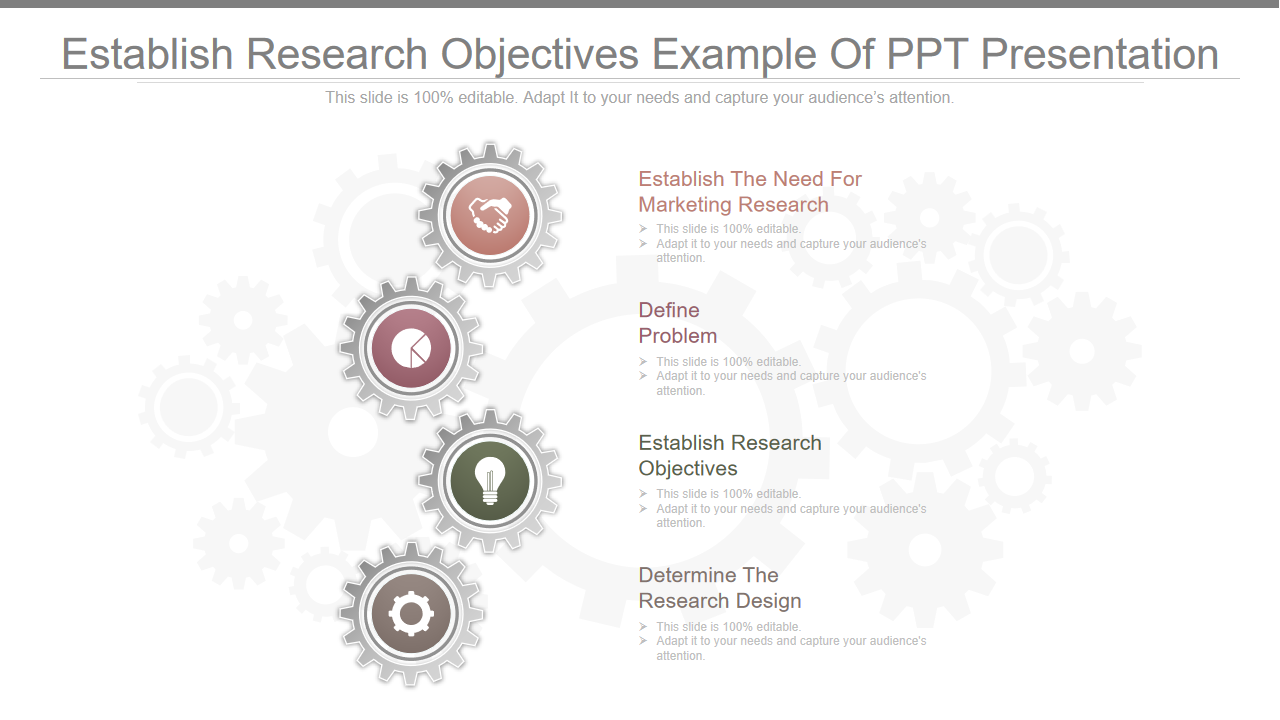
For an effective and meaningful research, clarity is essential. Deploy this template to facilitate that research objectives should specify the precise goals and targets of the study to assist in limiting its scope. To ensure the study's readability and comprehensibility, SlideTeam has crafted a flowchart template design to help you elucidate the study's objective, providing a basis for measuring and evaluating the success of well-defined research. Define and design your research with the help of this four-stage design pattern.
Template 8: A Company Research Venn Chart Presentation
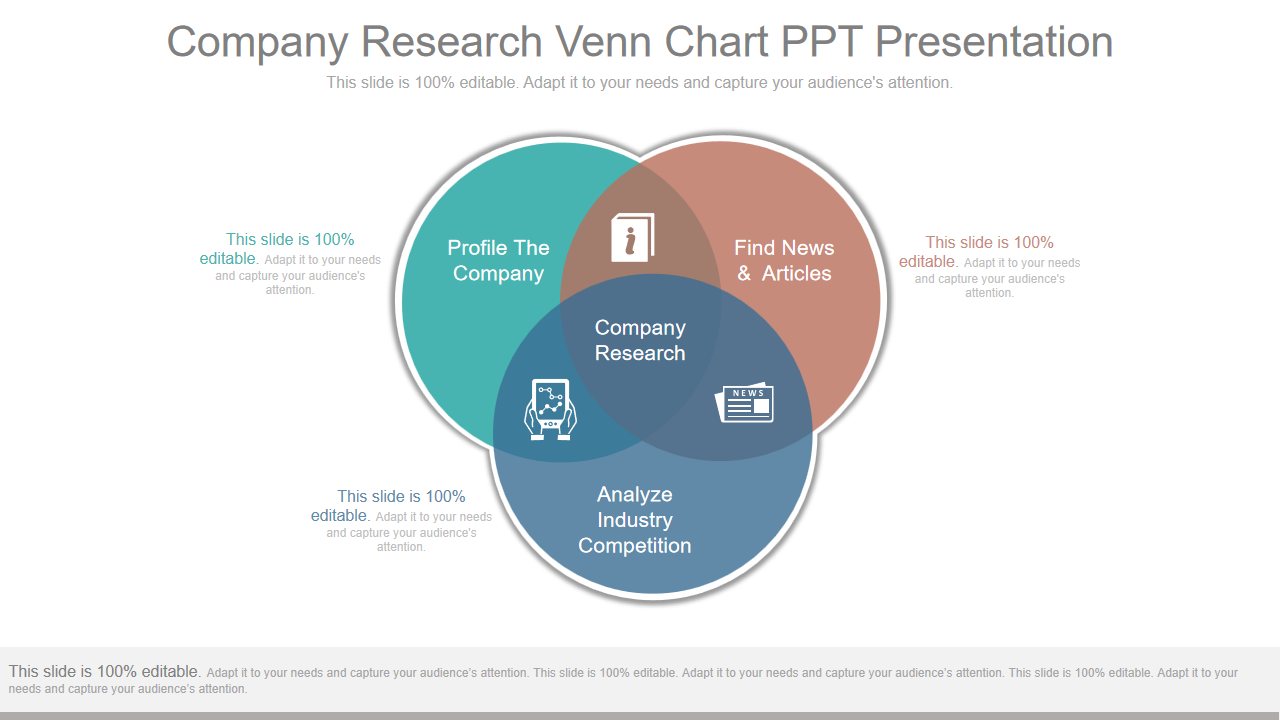
Establish relationships between the sets and groups of data while comparing and contrasting the company's research analysis. This template is helpful as it helps to understand the abstract, objectives, limitations, methodologies, research gap, etc., of the research effectively while focusing on postulating future recommendations and suggestions.
Template 9: Sample Research Paper Outline in a One-Pager Summary Presentation

How effortless it is to study a research paper without turning several pages? Grab this PPT template to research any topic and jot down your findings in a simple and concise format. Most importantly, a significant amount of their precious time can now be dedicated to critical tasks, aiding them in accelerating the research process. This incredibly well-curated one-pager template includes information about the introduction, problem, literature review, suggestions, and conclusions.

Template 10: Big Data Analytics Market Research Template
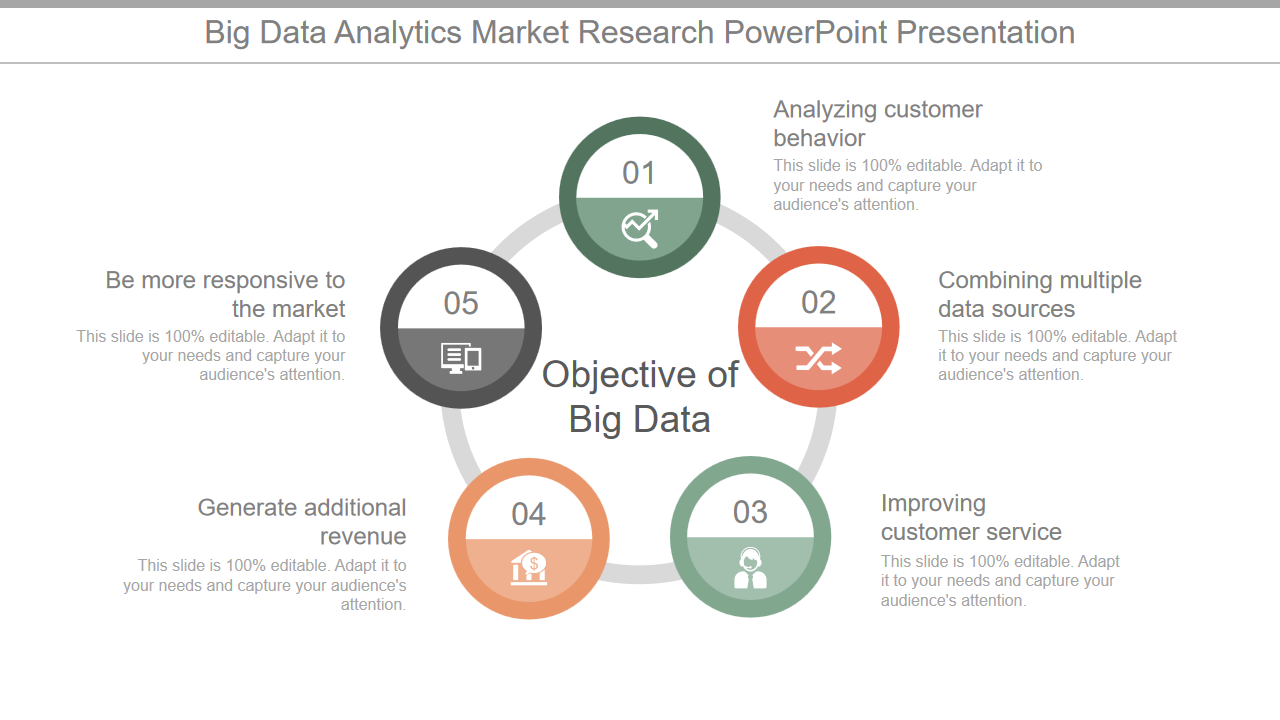
Deploy this template to introduce your company's extensive data analysis to understand the industry landscape, identify objectives, and make informed business decisions. Use this template slide to determine the current market size and growth rate. Consider the variables influencing this expansion, such as the rising volume of data produced and the demand for data-driven insights. Give information about the big data analysis market's prospects for the future. Over the coming few years, forecast growth trajectories, rising technologies, and market dynamics. Recognize the intended client base's demographics. Summarize your research and include suggestions for companies wishing to enter or grow in the big data analysis market.
PS: Provide an extensive statistical analysis for your research with this template. Check out now!
Refine your Research with SlideTeam.
SlideTeam introduces to its extensively built research templates that not only refines your search capability but also contributes towards the authenticity and development of your organization. It helps you to uncover veils of possibilities of growth while determining the bottlenecks and deriving appropriate solutions for future deliverables.
One of the attractive features about SlideTeam’s template are they are 100% customisable and editable as per the needs.
Download now!
PS: Provide an extensive statistical analysis for your research with this template . Check out now!
FAQs on Research Presentation
What is a research presentation.
Research Presentation is a visual representation of an individual or a team's observational findings or invocation in a particular subject.
What are the steps in research presentation?
To effectively convey your research findings to your audience, various phases are involved in creating a research presentation. Whether you're giving a presentation at a conference or a business meeting,
- Define your audience - Identify your audience's interests and level of knowledge. Make sure to adjust your presentation to fit their wants and needs.
- Outline What You Present - Create a clear structure with an introduction, three main ideas, and a conclusion. Choose the most essential points you want your audience to remember.
- Research and Data Collection - Gather and arrange the pertinent information, facts, and proof. Make sure your sources are reliable and current.
- Develop Visuals - To improve understanding, create visual aids like slides, charts, graphs, and photographs. Keep visuals straightforward, clutter-free, and with a distinct visual hierarchy.
- Get Your Audience Active - Take advantage of storytelling, anecdotes, or pertinent instances to draw in your audience. If appropriate, encourage audience participation and questions during the lecture.
- Present your argument - Start with a compelling introduction. Follow your outline while ensuring a logical and obvious flow.
- Keep an open line of communication, communicate clearly, and change your tone and pace. Improve your communication by making gestures and using body language. Respond to comments and questions as they come up or after the presentation.
- Recap and Draw a Conclusion - Summarize the core ideas and principal conclusions. Reiterate the importance of your study and its consequences.
How do you research a topic for a presentation?
To begin with, the idea of research presentation, choosing topics that align with your expertise and knowledge is the first and foremost. After understanding the topic, collect core factual and empirical data for proper understanding. After gauging information, it creates a place for every subtopic that must be introduced.
Related posts:
- Must-have Business Analyst Resume Templates with Examples and Samples
- Top 10 Data Processing Templates with Samples and Examples
- Must-have Data Mapping Document Templates with Samples and Examples
- Must-have Power BI Templates with Samples and Examples
Liked this blog? Please recommend us

Top 10 Business Model Templates with Samples and Examples

Top 7 Introduction Templates with Samples and Examples
This form is protected by reCAPTCHA - the Google Privacy Policy and Terms of Service apply.

Digital revolution powerpoint presentation slides

Sales funnel results presentation layouts
3d men joinning circular jigsaw puzzles ppt graphics icons

Business Strategic Planning Template For Organizations Powerpoint Presentation Slides

Future plan powerpoint template slide

Project Management Team Powerpoint Presentation Slides

Brand marketing powerpoint presentation slides

Launching a new service powerpoint presentation with slides go to market

Agenda powerpoint slide show

Four key metrics donut chart with percentage

Engineering and technology ppt inspiration example introduction continuous process improvement

Meet our team representing in circular format

- Program Design
- Peer Mentors
- Excelling in Graduate School
- Oral Communication
- Written communication
- About Climb
Creating a 10-15 Minute Scientific Presentation
In the course of your career as a scientist, you will be asked to give brief presentations -- to colleagues, lab groups, and in other venues. We have put together a series of short videos to help you organize and deliver a crisp 10-15 minute scientific presentation.
First is a two part set of videos that walks you through organizing a presentation.
Part 1 - Creating an Introduction for a 10-15 Minute Scientfic Presentation
Part 2 - Creating the Body of a 10-15 Minute Presentation: Design/Methods; Data Results, Conclusions
Two additional videos should prove useful:
Designing PowerPoint Slides for a Scientific Presentation walks you through the key principles in designing powerful, easy to read slides.
Delivering a Presentation provides tips and approaches to help you put your best foot forward when you stand up in front of a group.
Other resources include:
Quick Links
Northwestern bioscience programs.
- Biomedical Engineering (BME)
- Chemical and Biological Engineering (ChBE)
- Driskill Graduate Program in the Life Sciences (DGP)
- Interdepartmental Biological Sciences (IBiS)
- Northwestern University Interdepartmental Neuroscience (NUIN)
- Campus Emergency Information
- Contact Northwestern University
- Report an Accessibility Issue
- University Policies
- Northwestern Home
- Northwestern Calendar: PlanIt Purple
- Northwestern Search
Chicago: 420 East Superior Street, Rubloff 6-644, Chicago, IL 60611 312-503-8286
30+ Best Research Presentation Templates for PowerPoint (PPT)
Finding the right PowerPoint template plays an important part in getting your message across to the audience during a presentation. And it’s especially true for research presentations.
Using the right colors, graphs, infographics, and illustrations in your slides is the key to delivering information more effectively and making your presentation a success.
Today, we handpicked a great collection of research presentation PowerPoint templates for you to make the perfect slideshows for various types of research papers and studies.
Whether you’re preparing for a presentation at a school, event, or conference, there are templates in this list for all purposes. Let’s dive in.
2 Million+ PowerPoint Templates, Themes, Graphics + More
Download thousands of PowerPoint templates, and many other design elements, with a monthly Envato Elements membership. It starts at $16 per month, and gives you unlimited access to a growing library of over 2,000,000 presentation templates, fonts, photos, graphics, and more.

BeMind Minimal Template

Pitch Deck Templates
Startup pitch deck.

Business PPT Templates
Corporate & pro.

Pitch PowerPoint

Modern PPT Templates
New & innovative.

Animated PPT Templates
Fully animated.
Explore PowerPoint Templates
Science & Research Presentation PowerPoint Template

This PowerPoint template is a perfect choice for preparing a research presentation to share your scientific findings and reports.
The template has 30 unique slides with unlimited color options. There are a few infographics included in the slideshow as well.
Why This Is A Top Pick
The presentation has a very modern and creative design where you can showcase your data and information in an attractive way. You won’t be making boring research presentations ever again.
Labvire – Research Presentation PowerPoint Template

Labvire is another modern PowerPoint template you can use for various types of research presentations. It’s also ideal for laboratory-related research presentations. The template has fully customizable slide layouts with editable charts, graphs, and more. You can choose from more than 40 unique slide designs as well.
Novalabs – Science Research PowerPoint Template

Novalabs PowerPoint template features a highly visual and attractive design. The template includes 36 different slides that feature large image placeholders for adding a more visual look to your presentations. There are lots of editable graphics, shapes, and tables included in the template too. Feel free to customize them however you like.
Research & Development PowerPoint Template

The minimal and clean design of this PowerPoint template makes it a great choice for delivering more effective research presentations. With fewer distractions in each slide, you’ll be able to convey your message more easily. The template comes with 30 unique slides. You can change the colors, fonts, and shapes to your preference as well.
Marketing Research Presentation PowerPoint Template

When talking about research presentations, we can’t forget about marketing research. Most sales and marketing meetings usually include a sophisticated marketing research presentation. This PowerPoint template will help you design those research presentations without effort. It includes a total of 150 slides, featuring 30 unique slides in 5 different color schemes.
Free Business Market Research Presentation Template

This is a free PowerPoint template designed for making business market research presentations. It gives you 27 different and fully customizable slides to create professional slideshows for your business meetings.
Free Business Data Analysis & Research Presentation

With this PowerPoint template, you can create colorful and creative business research and data analysis presentation without any design skills. It includes 35 unique slides with lots of infographics and editable shapes. The template is free to use as well.
Lernen – Research Thesis PowerPoint Presentation

Larnen is the ideal PowerPoint template for making research slideshows for your thesis presentations. It includes 30 unique slides that are available in light and dark color themes. It also has editable charts and graphs.
Aristo – Research Academic PowerPoint Presentation

This PowerPoint template is also made with academic research presentations in mind. The template has a professional design with clean layouts and light colors. It comes with more than 30 different slides.
Biosearch – Science Research PowerPoint Template

You can use this PowerPoint template to make professional presentations to present research data and results. It lets you choose from 40 different slides and 90 color themes. The slides are available in both light and dark color themes as well.
Neolabs – Laboratory & Science Research PPT

Neolabs is another science research presentation made with laboratory research teams in mind. You can use it to make effective slideshows to present your research findings. There are 30 unique slides in this template.
Free Business Cost Analysis PowerPoint Template

This is a free PowerPoint and Google Slides template that comes with 35 unique slides. It’s ideal for making research presentations related to business financials.
Research & Case Study PowerPoint Template

Create the perfect case study presentation using your research data with this PowerPoint template. It includes a modern slide design with infographics and charts for effectively presenting your data.
Liron Labs – Laboratory Research PowerPoint Template

Another PowerPoint template for laboratory research presentations. This template includes 15 useful slide layouts with editable graphics, free fonts, and image placeholders. You can edit and customize the colors and text as well.
Research Thesis PowerPoint Template

Make an attractive and creative research thesis presentation using this PowerPoint template. There are over 30 unique slides in this template. You can either use dark or light color themes to create your presentations.
Colorful Thesis Research PowerPoint Template

If you want to make your research presentations look more colorful and creative, this PowerPoint template is for you. It has 15 different slides with fully customizable layouts. It has editable shapes, free fonts, and image placeholders too.
Free Data Analysis Research PowerPoint Template

This PowerPoint template is also free to download. You can also customize it using PowerPoint or Google Slides. This template is ideal for marketing agencies and teams for presenting research and data analysis.
Laboratory & Science Research PowerPoint Template

You can make more convincing and unique lab research presentations using this PowerPoint template. It features a creative design that will easily attract the attention of your audience. You can use it to make various other science and research presentations too. The template includes 30 unique slides.
The Biologist – Research Presentation PowerPoint Template

Just as the name suggests, this PowerPoint template is designed with biology and science-related presentations in mind. It includes many useful slide layouts that can be used to make various types of research presentations. There are 30 different slide designs included in this template with editable shapes and colors.
Modern Science & Research PowerPoint Template

If you’re looking for a PowerPoint template to create a modern-looking research presentation, this template is perfect for you. It features a collection of modern and attractive slides with lots of space for including images, icons, and graphs. There are 30 unique slides in the template with light and dark color themes to choose from.
Marketing Report & Research PowerPoint Template

This PowerPoint template doubles as both a research and report slideshow. You can use it to create various marketing reports as well as marketing research presentations. It comes with 30 slides that feature minimal and clean designs. It includes lots of editable charts, infographics, and tables as well.
Market Research Presentation PowerPoint Template

Another modern PowerPoint template for making market research presentations. This template includes 25 unique slides with master slides, image placeholders, and editable colors. The template is ideal for marketing agencies and corporate businesses.
Free Academic Research Thesis PowerPoint Template

This free PowerPoint template is designed for defending your academic research thesis dissertation. Needless to say, it’s a useful template for academics as well as teachers. The template features 23 unique slide layouts with customizable designs.
Free Economics Research Thesis Presentation Template

You can use this free template to create thesis and research presentations related to economics. It’s useful for academic students and gives you the freedom to choose from 21 slide layouts to make your own presentations.
Labia – Research Presentation Powerpoint Template

Labia is a research presentation template made for professionals. It comes with a set of modern slides with multipurpose designs. That means you can customize them to make many different types of research presentations. There are 30 unique slides included in this template that come in 5 different color themes.
Medical Research Infographics & Powerpoint Slides

You’ll be using lots of charts, graphs, and infographics in your presentations to showcase data in visual form. Not to mention that visuals always work well for attracting the audience’s attention. You can use the infographic slides in this template to create better research presentations. Each slide features a unique infographic with animated designs.
Foreka – Biology Education & Research Presentation PPT

Foreka is a PowerPoint template made for educational presentations, especially for covering topics related to biology. But it can also be customized to present your research presentations. The slides have very useful layouts that are most suitable for making research slide designs. There are 30 slides included with light and dark color themes.
Maua – Aesthetic Business Research PowerPoint Template

This PowerPoint template is suitable for making elegant and stylish business reports and business research presentations. It’s especially great for making background research and competitor research slideshows. The template comes with 30 slides featuring master slides, image placeholders, and more.
World Data Scientist Powerpoint Presentation Template

You can use this PowerPoint template to create research presentations for many different types of topics, industries, and projects. The template includes lots of data-centric slides where you can easily showcase your data in visual form. There are 30 unique slides included with the template as well.
Free SWOT Analysis Infographics PowerPoint Template

SWOT analysis is a commonly used methodology in business research presentations. With this free PowerPoint template, you can create stylish SWOT analysis infographics for your presentations. It includes SWOT infographics in 30 different styles.
Free Market Research Presentation Infographics PPT

This is a collection of free PowerPoint slides that feature various styles of infographics you can use in your business and market research presentations. There are 30 different infographic slides included in this template. You can edit, change colors, and customize them however you like.
Sinara – Science & Research Powerpoint Template

Sinara is a brilliant PowerPoint template you can use to craft a professional presentation for science-related research and reports. It’s available in 3 different color schemes as well as the option to customize the colors to your preference. The template comes in light and dark themes too.
Political Science and Research PowerPoint Template

This PowerPoint template will be quite useful to political science and international relations students. It features a total of 150 slides you can use to create attractive presentations for your research and methodologies. There are slides in 5 different color schemes.
How to Make a Research Poster in PowerPoint
We bet you didn’t know that you could actually design posters in PowerPoint. Well, you can and it’s very easy to do so.

The easiest way to make a poster in PowerPoint is to use a pre-made template like the one above.
You can easily copy one of the slides from a template, and resize the slide dimensions to create a vertical poster. Then add a title with a few lines of text and you’ll have yourself a poster.
Or, if you want to craft a poster from scratch, you can read our complete guide on how to create posters in PowerPoint with step-by-step instructions.
For more useful presentation templates, be sure to check out our best educational PowerPoint templates collection.
- Dean Keith Simonton, PhD
- Publication Lists
- Representative Articles
- Works In Progress
- Honored Publications
- Book Reviews
- Professional Presentations
- Sample PowerPoints
- Personal Statement
- Student Viewpoint Evaluations
- Teaching Achievements and Activities
- Personal Interests
Sample Powerpoint Presentations
Below is a collection of recent presentations that convey the diversity of topics addressed on different occasions from 2003 on. Within each category the powerpoints are listed in alphabetical order by title. The presentations are converted into pdfs and the links provided.
Invited/Keynote/Award/Presidential Addresses
Conferences
Miscellaneous
Click on the highlighted title to download the set of slides. Select either “Open” or “Save.” In the former case, run the presentation within the web browser by using the left click button on the mouse; in the latter case, open the saved file using power-point software and then run it via the usual assortment of options.
- IEEE Xplore Digital Library
- IEEE Standards
- IEEE Spectrum

- IEEE Brand Overview
- Frequently asked questions
- IEEE Master Brand and Logos
- Geo-unit & Section Resources
- IEEE Society Sub-Brand Resources
- IEEE Council Sub-Brand Resources
- Brand Identity Guidelines
- IEEE Style Guide and Requirements
- IEEE.org Content Review Guidelines
- Mobile/app and Responsive Design Guidelines
- Other Site Management Guidelines
- IEEE Website and Social Media Site Registration Form
- Social Media Overview
- Social Media Training Resources
- How to utilize collateral & templates
IEEE Corporate Presentation Templates
- Digital use collateral
- Print collateral and editable templates
- Promotional advertising collateral
- Website templates
- 140 years of IEEE—Marketing Toolkit
- Adapting Your Marketing Communications to the Environment Around You
- IEEE App Marketing Toolkit
- IEEE Collabratec Toolkit
- IEEE Day Toolkit
- IEEE Digital Marketing Campaign Toolkit
- IEEE Education Week Toolkit
- IEEE eLearning 50% Discount Toolkit
- IEEE Open Access Toolkit
- IEEE Periodical Journals Marketing Toolkit
- IEEE Publicity Toolkit
- IEEE Social Media and Communications Toolkit for Authors
- IEEE Social Media Toolkits
- IEEE Strategic Plan Toolkit
- IEEE Students Toolkit
- IEEE Volunteering Toolkit
- IEEE Your Professional Home Toolkit
- Promo Library
- IEEE branded virtual backgrounds for video conferencing tools
- IEEE Virtual UX Lab
- IEEE Brand Experience Bulletin
- Brand videos
- Digital Resources
- IEEE Experience Design Team Contact Form
- IEEE Brand Inquiries Form
- Frequently Asked Questions
- IEEE Experience Design Team Project Process
- Creative Portfolio
- Service level agreements
- Public visibility
- Print Collateral and Editable Templates
- IEEE Website Templates
- How to Utilize Collateral & Templates
- IEEE Website Templates Access Request Form
- Digital Use Collateral
- Promotional Advertising Collateral
Create new presentations and refresh existing ones by using the branded IEEE Corporate Presentation Templates. Templates are available in high resolution and basic formats and support fullscreen as well as widescreen display on Windows and Mac computers.
On this page:
IEEE Presentation Template Quick Start Guide
Primary presentation template - ieee blue, alternate color presentation templates.
- Additional Branded PowerPoint options
Report Templates
- NEW: IEEE Corporate PowerPoint Quick Start Guide
- PowerPoint options
Use the following basic versions of the IEEE presentation templates if you are working in areas with low internet bandwidth. Microsoft PowerPoint, Google Slides, and Keynote versions are available below.

IEEE Blue (Pantone 3015) - Microsoft PowerPoint Template (PPTX, 6.1 MB) IEEE Blue (Pantone 3015) - Google Slides Template IEEE Blue (Pantone 3015) - Keynote for Mac Template (7.9 MB)
These decks each contain a full set of slides in one color theme with coordinating imagery. Select IEEE Brand Blue or one of the 3 additional colors from the approved IEEE Brand Color Palette.

- Red (Pantone 200) - PowerPoint Template (PPTX, 12.4 MB)
- Red (Pantone 200) - Google Slides Template

- Cyan - PowerPoint Template (PPTX, 9 MB)
- Cyan - Google Slides Template

- Navy (Pantone 295) - PowerPoint Template (PPTX, 8.3 MB)
- Navy (Pantone 295) - Google Slides Template
Additional Branded PowerPoint Options
These decks each contain a full set of slides each with a unique design theme. These include a title slide, divider slide, and text slide options. Some options have placeholders for sub-brand logos.

Abstract Polygons (PPTX, 10 MB)

Global View (PPTX, 12.4 MB)

Brand Circuit (PPTX, 721 KB)

Event Series (PPTX, 57.2 MB)
If you have trouble downloading the files, please submit your request via the IEEE Experience Design Team Contact Form .

IEEE Report Template - Letter Sized (DOCX, 4.3 MB) IEEE Report Template - A4 Sized (DOCX, 3.3 MB )
Home | Sitemap | Contact | Accessibility | Nondiscrimination Policy | IEEE Ethics Reporting | IEEE Privacy Policy | Terms & Disclosures | Site Feedback
© Copyright 2024 IEEE – All rights reserved. A not-for-profit organization, IEEE is the world's largest technical professional organization dedicated to advancing technology for the benefit of humanity.
Got any suggestions?
We want to hear from you! Send us a message and help improve Slidesgo
Top searches
Trending searches

11 templates

28 templates

holy spirit
36 templates

islamic history

memorial day
12 templates

165 templates
Conference Presentation templates
Having a conference due soon is always a stressful moment but you can make it more easy-going with a cool presentation with exactly what you need give a presentation about your next conference with one of these templates carefully designed for the occasion choose the one of your taste which suits your concept and company best.

Geometric Conference Style Presentation
Download the "Geometric Conference Style Presentation" for PowerPoint or Google Slides and start impressing your audience with a creative and original design. Slidesgo templates like this one here offer the possibility to convey a concept, idea or topic in a clear, concise and visual way, by using different graphic resources....
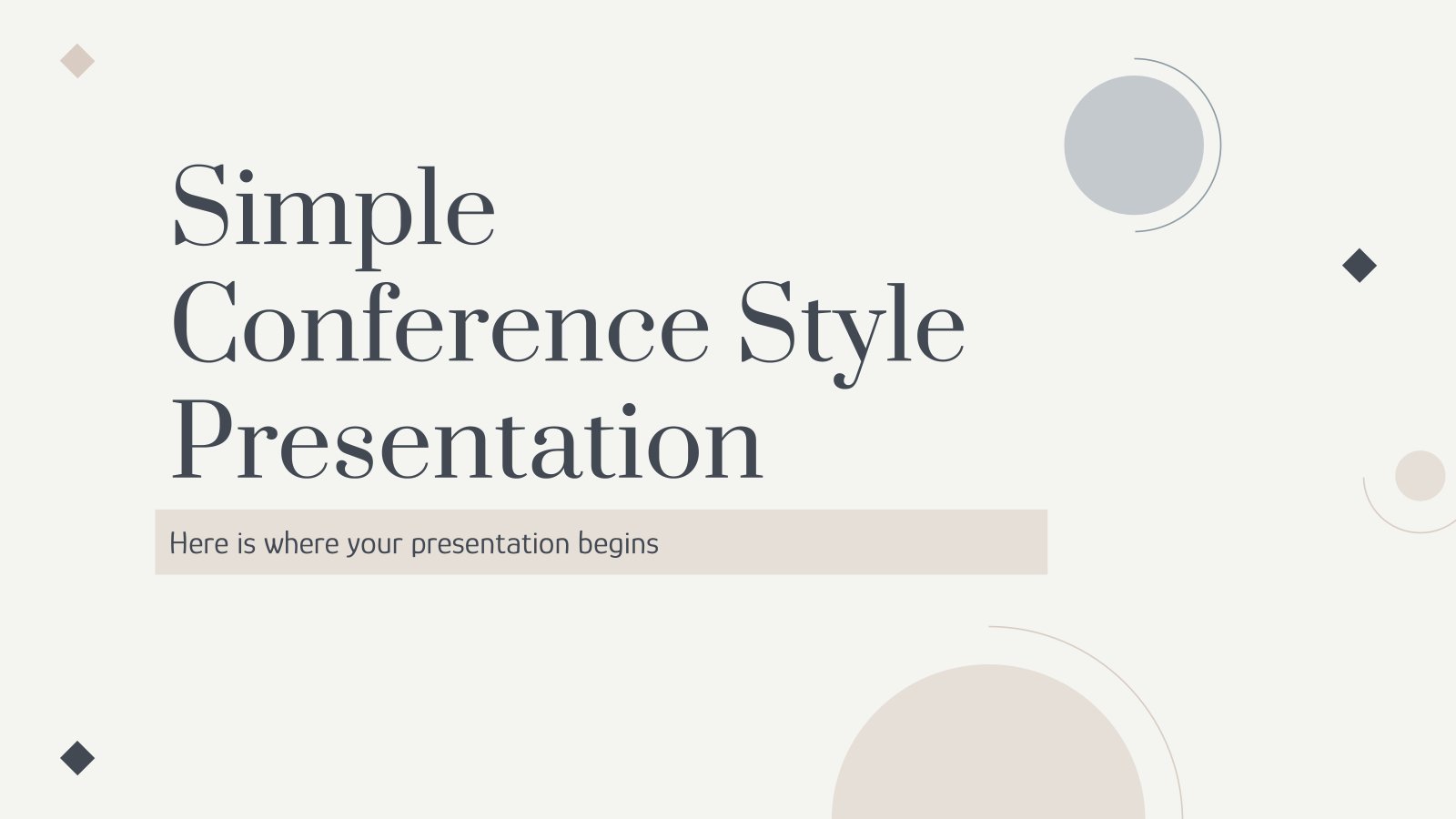
Simple Conference Style Presentation
Download the "Simple Conference Style Presentation" for PowerPoint or Google Slides and start impressing your audience with a creative and original design. Slidesgo templates like this one here offer the possibility to convey a concept, idea or topic in a clear, concise and visual way, by using different graphic resources....

Premium template
Unlock this template and gain unlimited access
Skin Diseases Conference
A conference on skin diseases could bring together some of the leading experts in the field from around the world. Attendees would learn about the latest treatments, research, and developments in skin disease prevention, diagnosis, and management. There would be a variety of presenters from hospitals, universities, and non-profits who...
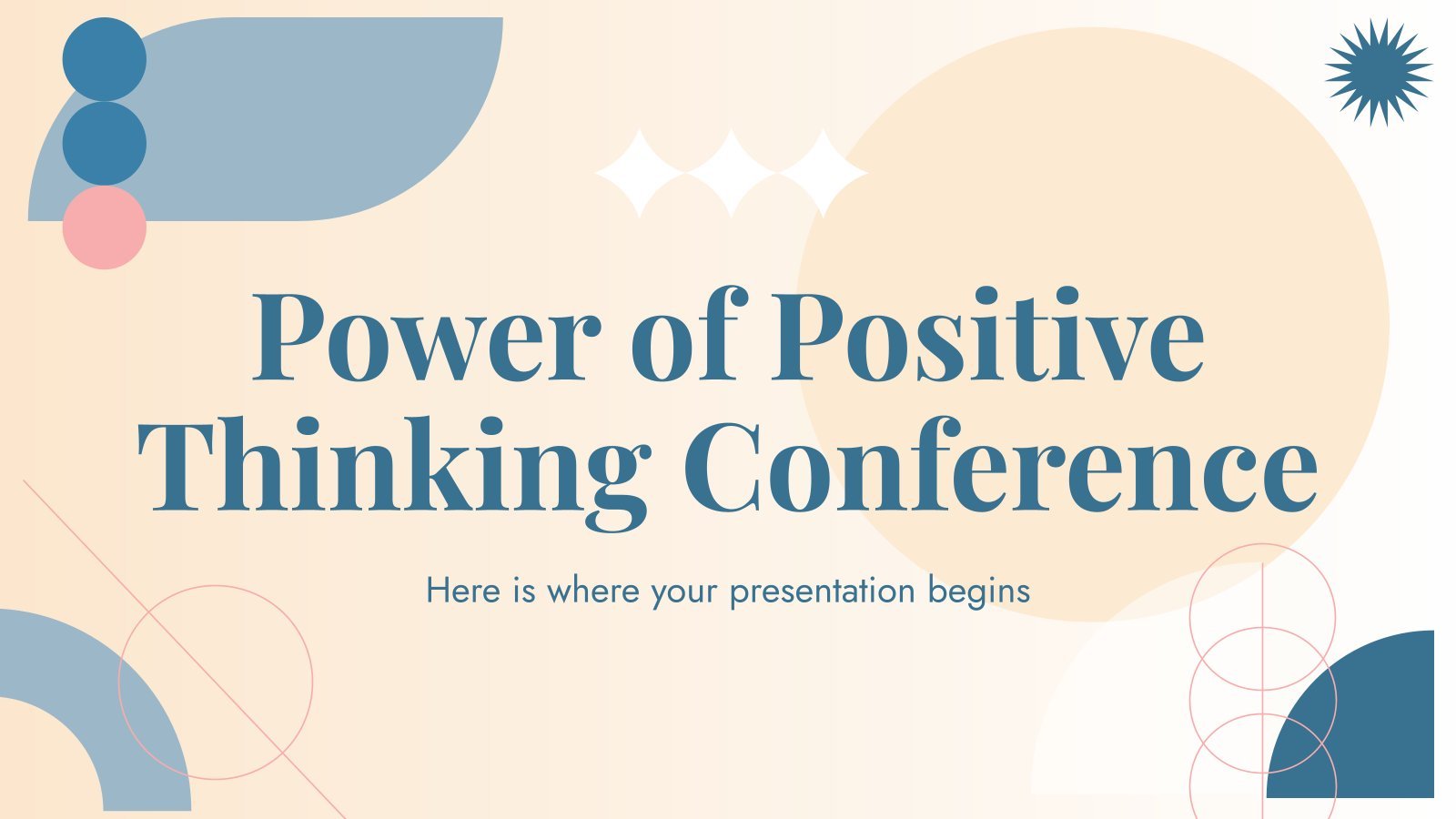
Power of Positive Thinking Conference
The power of a positive thinking conference is where positivity meets productivity. Attendees will leave with a renewed outlook, an arsenal of practical techniques and the confidence to turn their dreams into reality! From learning how to make your mindset work for you to getting creative for your business, your...
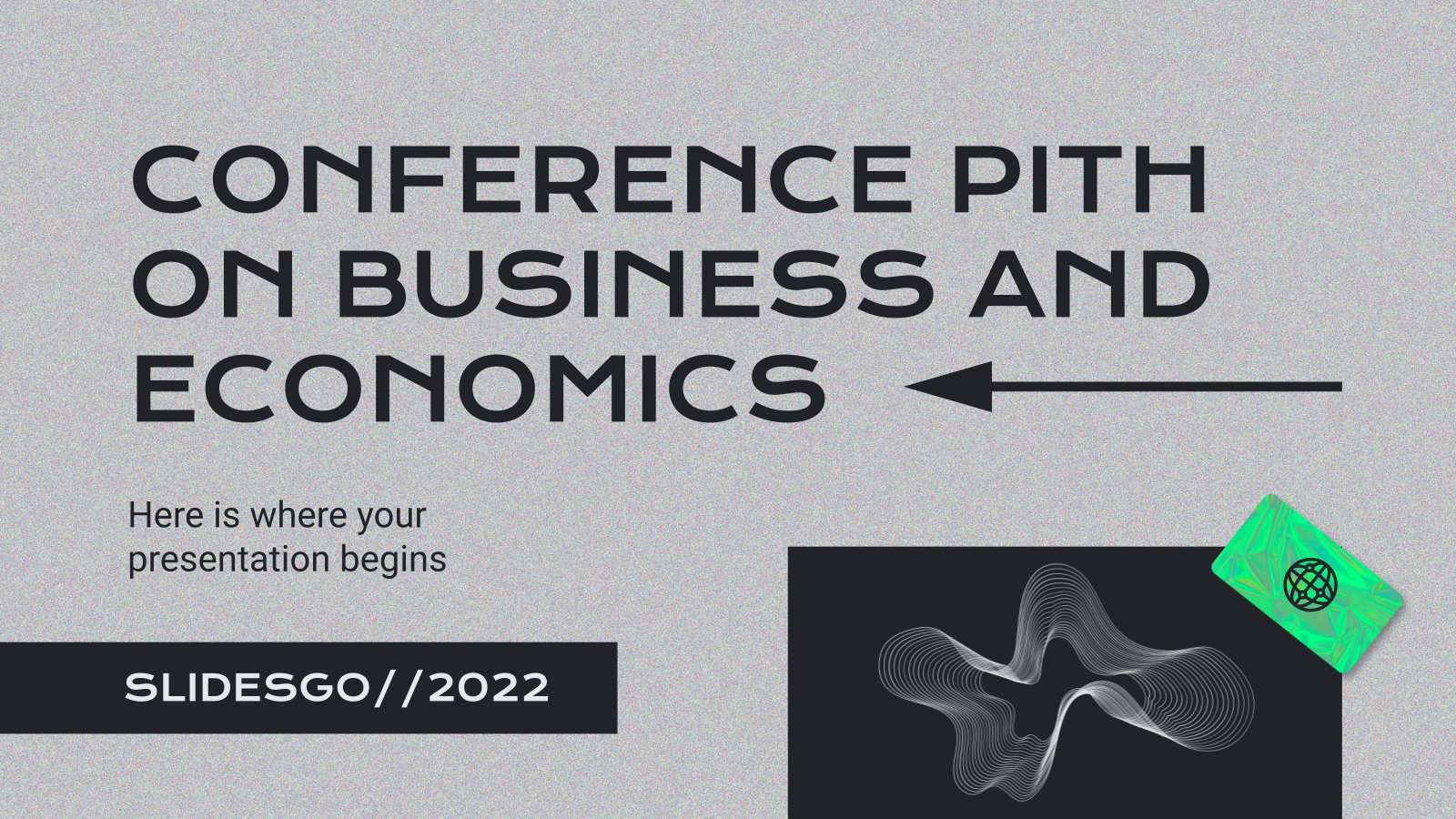
Conference Pitch on Business and Economics
It will be a good conference if you accompany it with a good visual support, like this presentation! If you have checked your calendar, you have seen that in two weeks you have to give a conference on business and economy and you need a template to highlight the most...
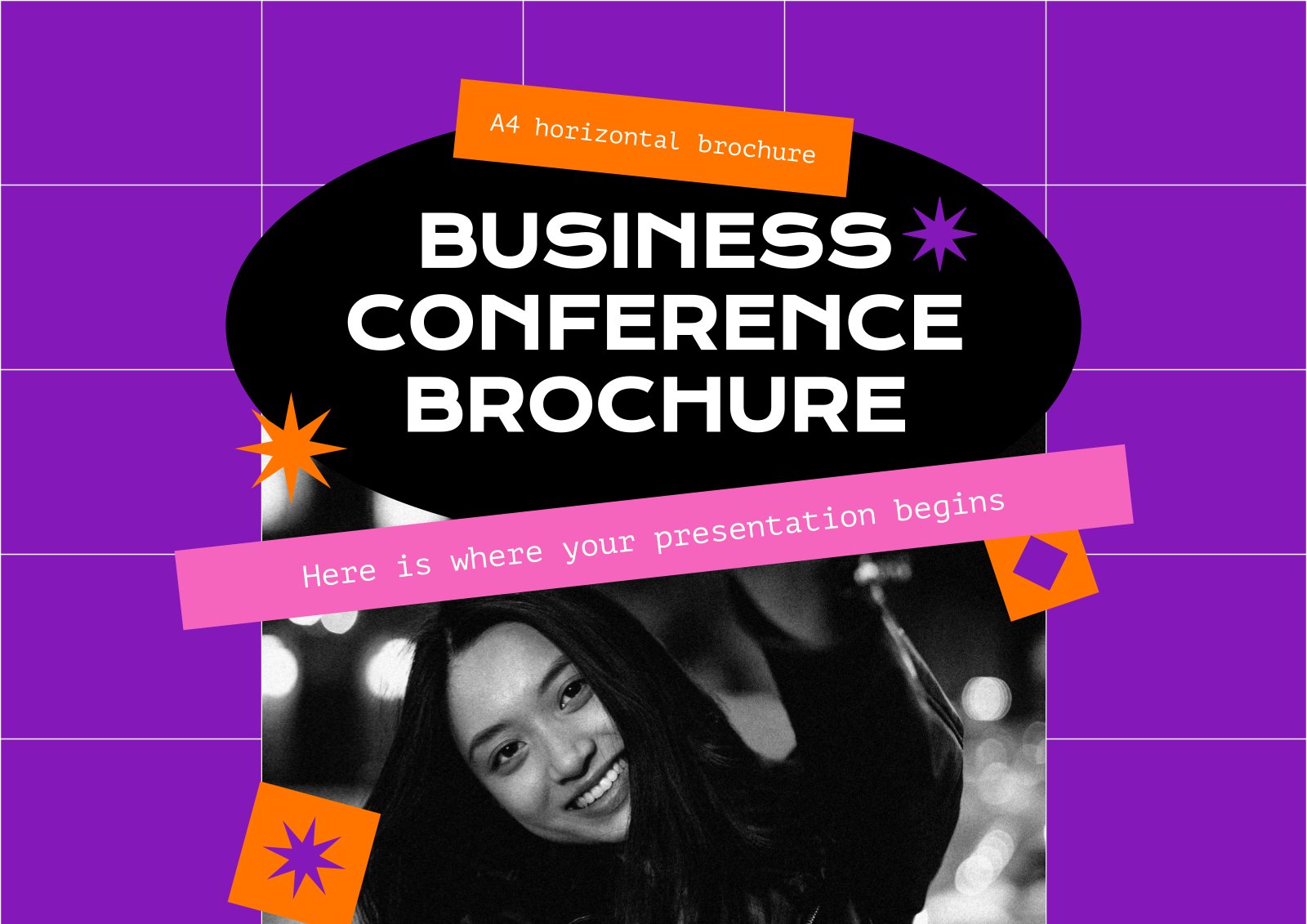
Business Conference Brochure
"Hello, would you like to come to our conference? Here's a brochure with the program and the timetable, be sure not to miss it!". Design the brochure that is mentioned in this hypotetical scenario and include the essential information that any person interested might need. It's creative, it grabs attention...
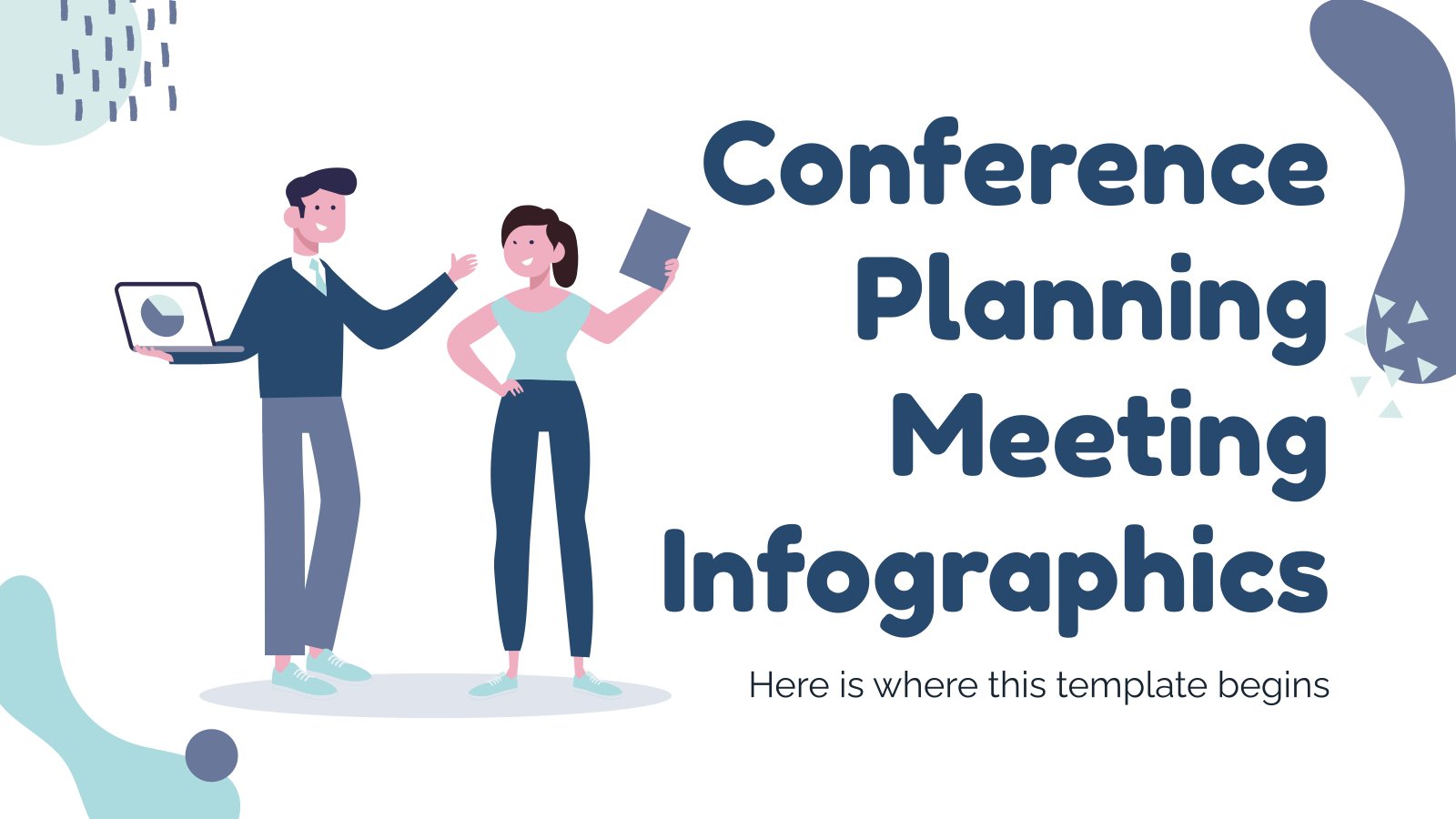
Conference Planning Meeting Infographics
Is there anything more stressful than planning a whole conference? Not that we can think of, really… but on the plus side, we’ve figured out a way to make your conference planning meeting a good bit less tedious: This collection of infographics specifically designed around everything that needs to be...

Formal Conference Style Presentation
Download the Formal Conference Style Presentation presentation for PowerPoint or Google Slides and start impressing your audience with a creative and original design. Slidesgo templates like this one here offer the possibility to convey a concept, idea or topic in a clear, concise and visual way, by using different graphic...

Creative Conference Style Presentation
Download the "Creative Conference Style Presentation" for PowerPoint or Google Slides and start impressing your audience with a creative and original design. Slidesgo templates like this one here offer the possibility to convey a concept, idea or topic in a clear, concise and visual way, by using different graphic resources....
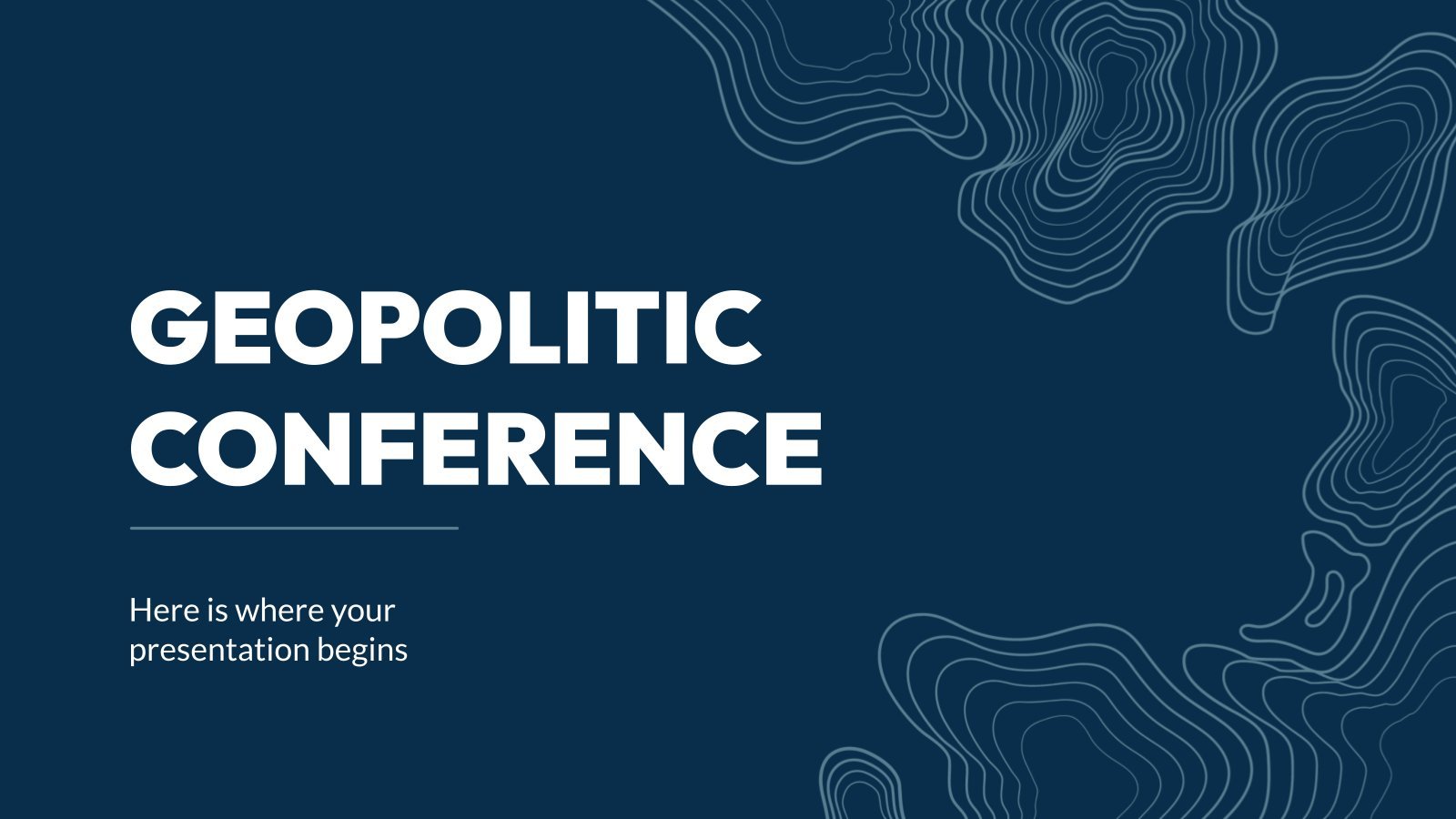
Geopolitic Conference
Explore the complex and dynamic world of international politics and global affairs with this geopolitical conference Google Slides and PowerPoint template. With its unique color palette of muted blue and beige and topographic line illustrations, it is the perfect tool to help you create a visually stunning and engaging presentation...

Download the "Formal Conference Style Presentation" presentation for PowerPoint or Google Slides and start impressing your audience with a creative and original design. Slidesgo templates like this one here offer the possibility to convey a concept, idea or topic in a clear, concise and visual way, by using different graphic...

Medical Conference Style Presentation
Download the "Medical Conference Style" presentation for PowerPoint or Google Slides. Healthcare goes beyond curing patients and combating illnesses. Raising awareness about diseases, informing people about prevention methods, discussing some good practices, or even talking about a balanced diet—there are many topics related to medicine that you could be sharing...
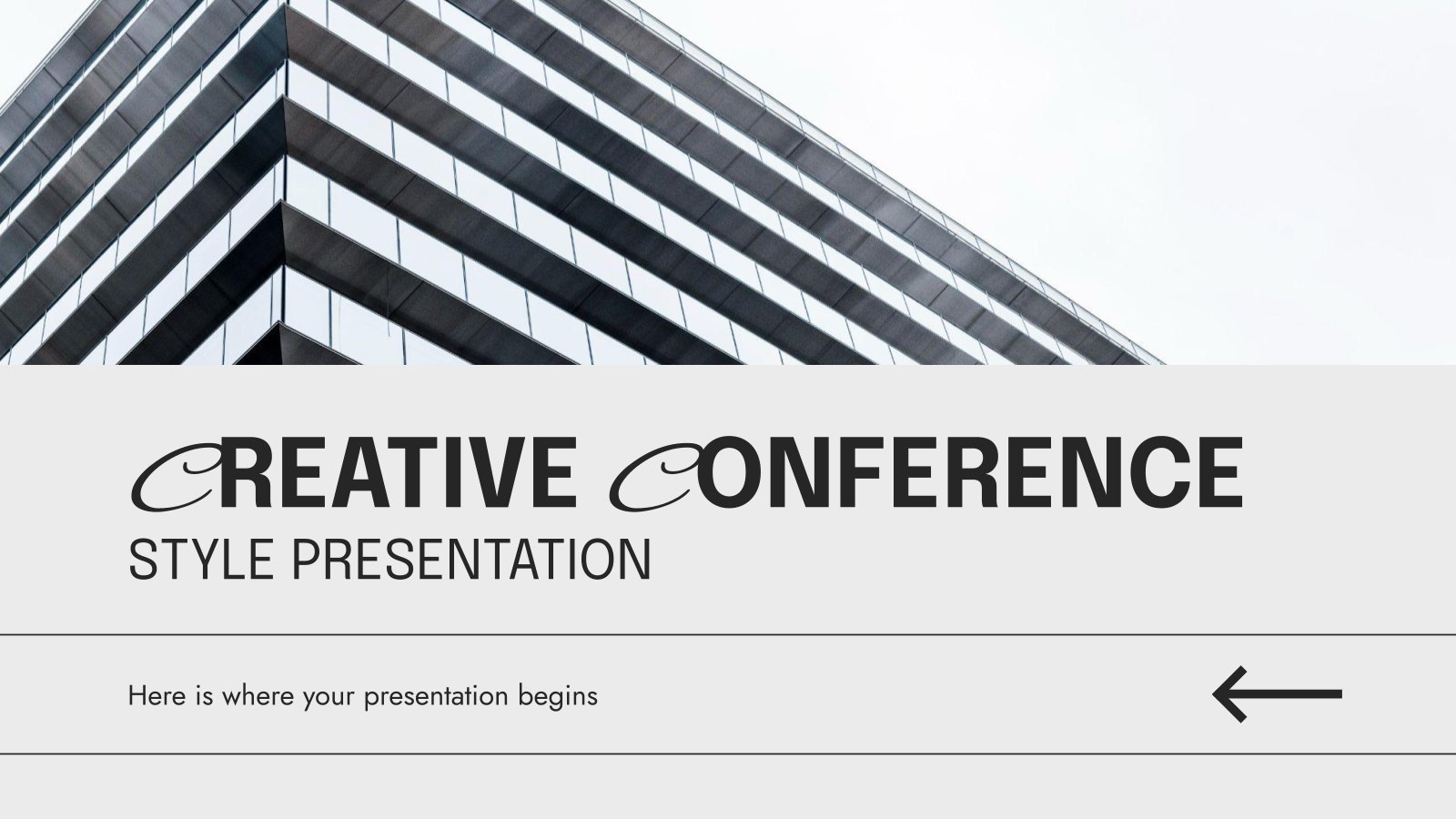
Download the Creative Conference Style Presentation presentation for PowerPoint or Google Slides and start impressing your audience with a creative and original design. Slidesgo templates like this one here offer the possibility to convey a concept, idea or topic in a clear, concise and visual way, by using different graphic...
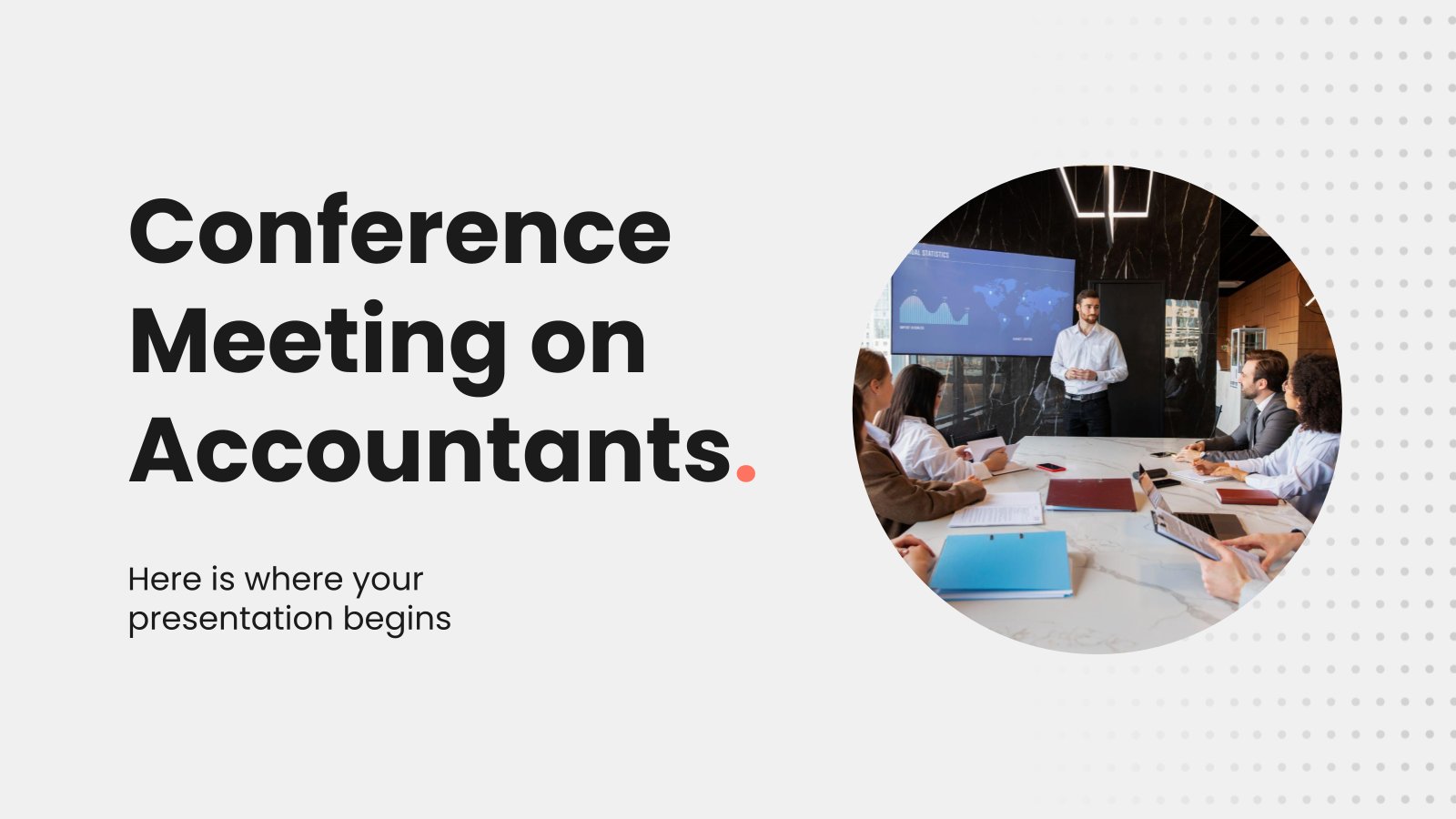
Conference Meeting on Accountants
Accountants play an important role within companies, as they are responsible for ensuring that finances are running smoothly. It’s always important to share knowledge, new tools, tricks, etc. So why not hold a conference that brings together the maximum number of accountants? In this template you will find the resources...

Minimalist Conference Style Presentation
Download the "Minimalist Conference Style Presentation" for PowerPoint or Google Slides and start impressing your audience with a creative and original design. Slidesgo templates like this one here offer the possibility to convey a concept, idea or topic in a clear, concise and visual way, by using different graphic resources....
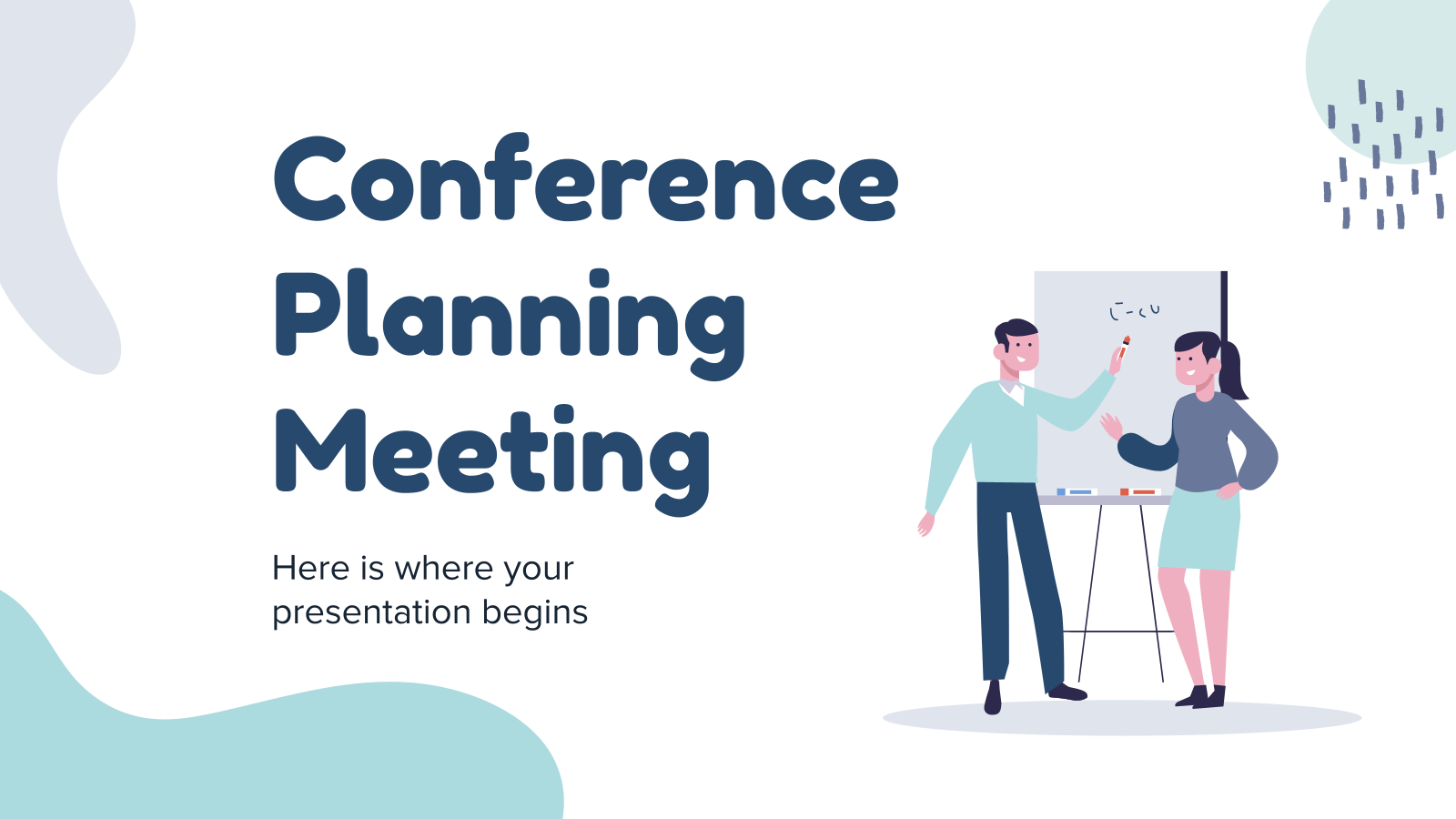
Conference Planning Meeting
The conference is coming up soon. Quick, you need to plan ahead and hold a meeting to discuss how to prepare for it! Since you'll need a presentation, download this one and customize it. To make your life easier, we've added all kinds of layouts: from calendars and timelines to...

Student-Led Conference
When it comes to student-led conferences, it's important to make sure that the presentation looks and feels professional. A well-designed template can make all the difference in how your audience perceives you and your work. That's why we've created a Google Slides and PowerPoint template that's perfect for conferences of...
- Page 1 of 6
Great presentations, faster
Slidesgo for Google Slides :
The easy way to wow

Register for free and start editing online

COMMENTS
Some characteristics differentiate conference presentations from other formats. Time-restricted. Conference presentations are bounded by a 15-30 minute time limit, which the event's moderators establish. These restrictions are applied to allow a crowded agenda to be met on time, and it is common to count with over 10 speakers on the same day.
Theory vs. methods vs. data. In order of importance, write down all the points you want your viewer to understand. Focus your presentation on the first three points. Include sections similar to a typical journal article. SUMMARIZE! Aim for approximately 1 minute per slide. Usually 10-15 slides total.
Tips for research paper presentation in national conferences and international conferences with sample ppt examples. For Business Enquiries: https://bit.ly/3...
Research conference presentation slides do not have to be self-explanatory. In this post, you will learn three crucial tips for preparing scientific conference presentation slides to efficiently explain your research. Tip No.1: One thought per slide. Tip No.2: Presentation slides are for visual information. Tip No.3: Use action titles.
A research paper presentation is often used at conferences and in other settings where you have an opportunity to share your research, and get feedback from your colleagues. Although it may seem as simple as summarizing your research and sharing your knowledge, successful research paper PowerPoint presentation examples show us that there's a ...
Research Conference Presentations: Some Tips and Examples. Useful Tips. Research talk 101 (by Lucia Dettori) How not to give a presentation (from ScienceRoll) Examples of Short Talks (PowerPoint files): Mark's example of a bad research presentation. Mark's example of a somewhat better research presentation.
Related Articles. This guide provides a 4-step process for making a good scientific presentation: outlining the scientific narrative, preparing slide outlines, constructing slides, and practicing the talk. We give advice on how to make effective slides, including tips for text, graphics, and equations, and how to use rehearsals of your talk to ...
Presentations with strong narrative arcs are clear, captivating, and compelling. Orient the audience and draw them in by demonstrating the relevance and importance of your research story with strong global motive. Provide them with the necessary vocabulary and background knowledge to understand the plot of your story.
Outline of Conference Presentation Results (3-4 slides). Present key results of study or data analysis. Don't superficially cover all results; cover key results well. Summary (1 slide). Future work (0-1 slides). Optionally give problems this research opens up. Total of 10-15 slides depending on time.
Template 1: Clinical Research Trial PowerPoint Template . Use this premium PPT template to captivate your audience. Download this well-created template to raise your presenting threshold. Establish your milestones with workflows designed to ease the overburdening of tasks. State clear-cut objectives to specify your aim and deliver a timeline.
First is a two part set of videos that walks you through organizing a presentation. Part 1 - Creating an Introduction for a 10-15 Minute Scientfic Presentation. Part 2 - Creating the Body of a 10-15 Minute Presentation: Design/Methods; Data Results, Conclusions. Two additional videos should prove useful: Designing PowerPoint Slides for a ...
Science & Research Presentation PowerPoint Template. This PowerPoint template is a perfect choice for preparing a research presentation to share your scientific findings and reports. The template has 30 unique slides with unlimited color options. There are a few infographics included in the slideshow as well.
And once you're ready, grab an editable research presentation template from Canva. Finding the right PPT template for your research presentation is a breeze with Canva. Our design gallery has hundreds of unique templates you can use, whether you're presenting to prospective clients at work, to colleagues at a conference, or to instructors ...
Sample Powerpoint Presentations. Below is a collection of recent presentations that convey the diversity of topics addressed on different occasions from 2003 on. Within each category the powerpoints are listed in alphabetical order by title. The presentations are converted into pdfs and the links provided.
Qualitative analysis relies on non-numerical methods such as interviews or surveys and quantitative ones use mathematical or statistical methods. If you need to present both results for your next research conference, this template is perfect to support your data! Make sure to include both qualitative and quantitative results in your analysis ...
The research PowerPoint template can enhance your presentations by providing a professional and organized layout specifically designed for research-related content. With its clean design and customizable elements, it allows you to effectively showcase your findings, data, and analysis, making your presentation visually appealing and engaging.
From research proposals to corporate presentations, academic lectures to project updates, class reports to sales pitches, we've got them all. Set yourself apart from the crowd and deliver an unforgettable presentation. Explore these one-of-a-kind and interactive PowerPoint templates for conference presentations by Canva today.
Download and customize our Research-related Google Slides and PowerPoint templates and give informative presentations Free Easy to edit Professional ... Here's our new free presentation template with a focus on... Education. 16:9 ... Download the "Project Research Infographics" template for PowerPoint or Google Slides and discover the power ...
Alternate Color Presentation Templates. These decks each contain a full set of slides in one color theme with coordinating imagery. Select IEEE Brand Blue or one of the 3 additional colors from the approved IEEE Brand Color Palette. Red (Pantone 200) - PowerPoint Template (PPTX, 12.4 MB)
Download the Simple Conference Style Presentation presentation for PowerPoint or Google Slides and start impressing your audience with a creative and original design. Slidesgo templates like this one here offer the possibility to convey a concept, idea or topic in a clear, concise and visual way, by using different graphic... Multi-purpose. 16:9.